Publications
Group highlights
At the end of this page, you can find the full list of publications. All papers are also available on Google Scholar or Pubmed.

We propose an unsupervised domain adaptation framework with class-imbalance self-training and variance-guided feature extrapolation that achieves robust segmentation across multi-vendor cine, T1, and LGE MRI without sequence-specific annotations, outperforming existing methods in Dice coefficient and Hausdorff distance.
F. Xing et al.
IEEE J. Biomed. Health Informatics (2026)
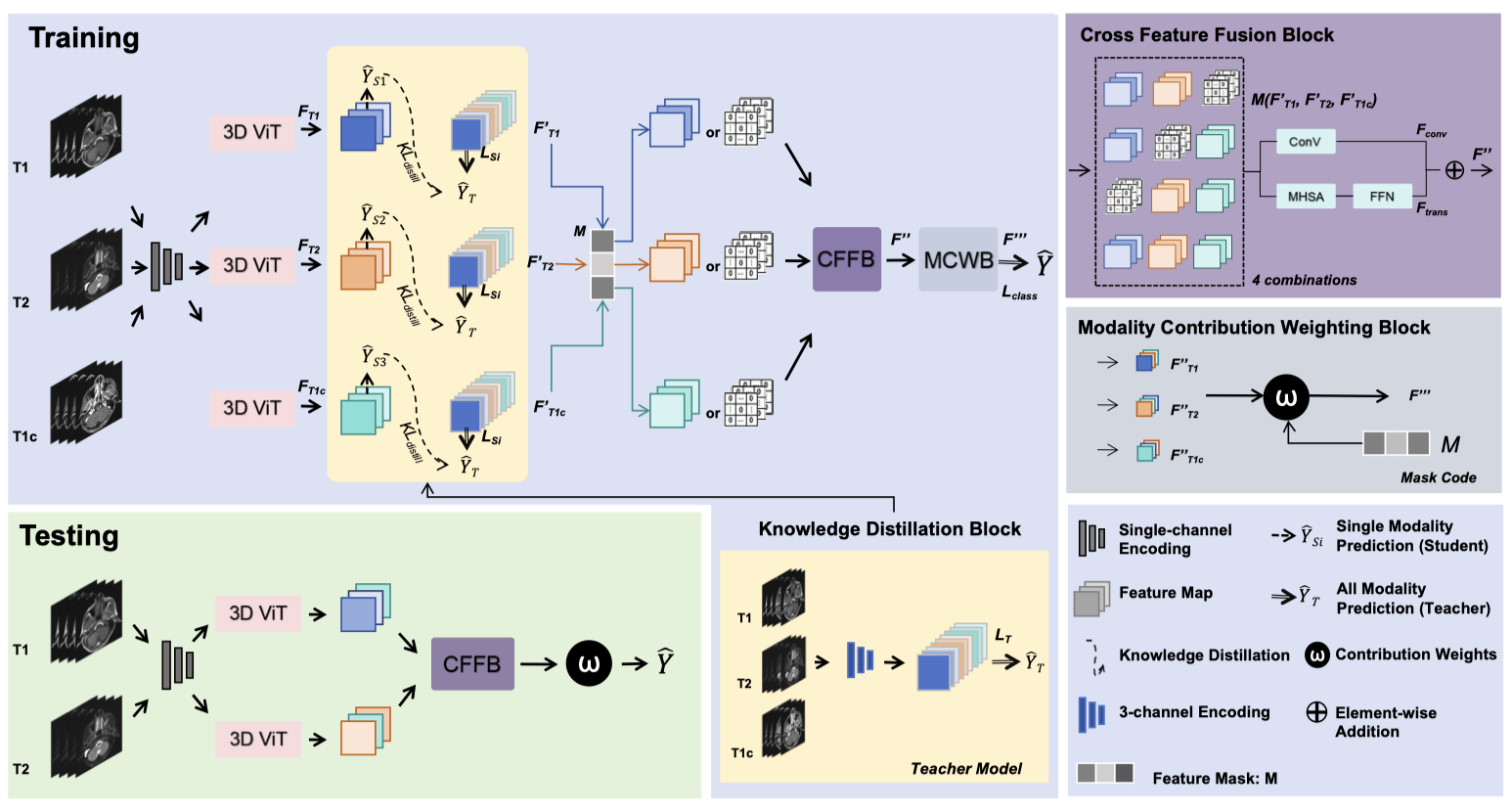
Contrast-enhanced T1-weighted MRI using gadolinium-based contrast agents has been crucial for nasopharyngeal carcinoma diagnosis, but safety concerns have prompted research into alternative methods. This study developed a diagnostic model using non-contrast images that achieved high accuracy comparable to contrast-enhanced imaging, suggesting a promising contrast-free approach for NPC detection.
Z. Li et al.
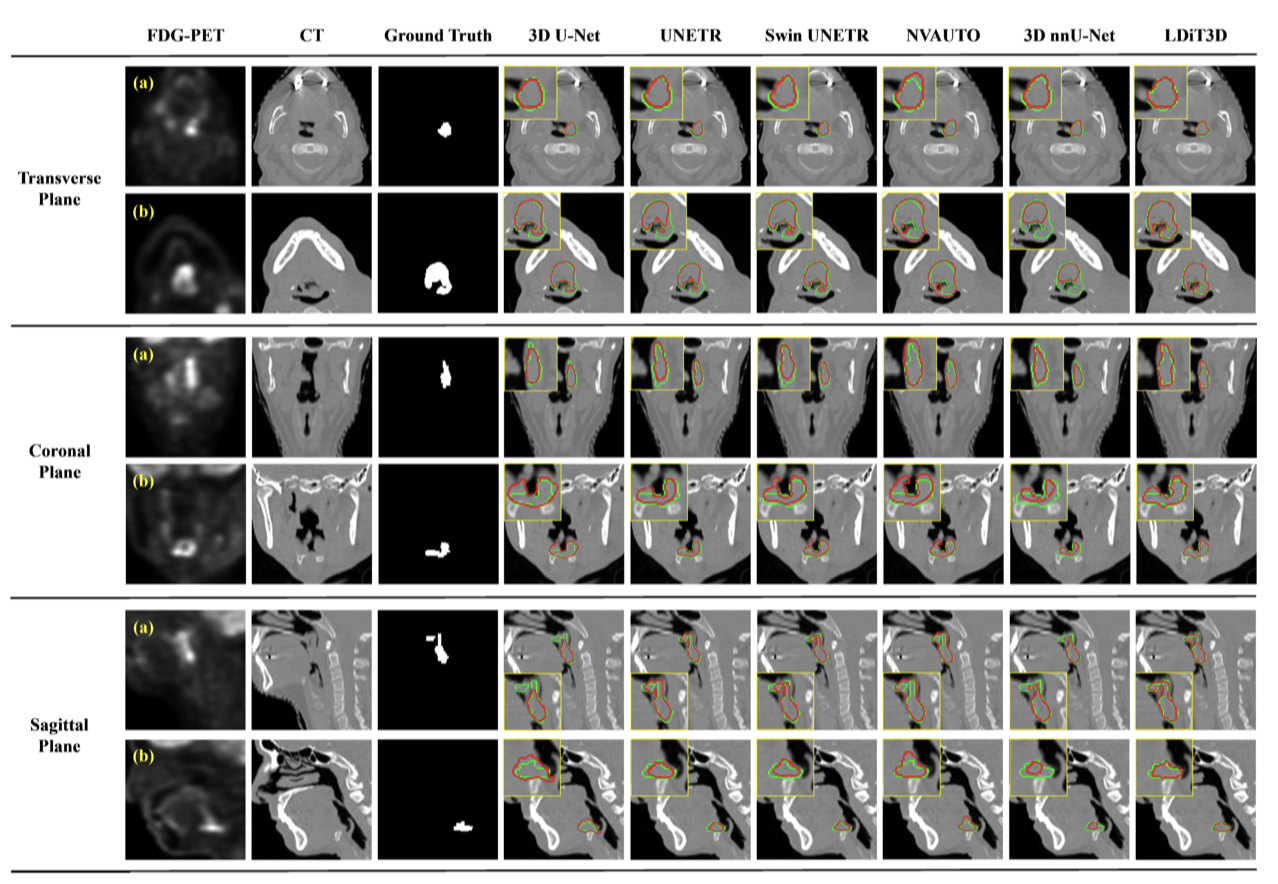
LDiT3D is a 3D latent diffusion model using transformer architecture that automates head and neck tumor segmentation from FDG-PET and CT scans, operating efficiently in a compressed latent space created by a pre-trained autoencoder. Trained on over 500 patients, it outperforms existing U-Net and transformer-based models with a Dice Score of 77.60%, demonstrating superior accuracy and clinical potential for reducing clinicians’ segmentation burden.
Y. Dong et al.
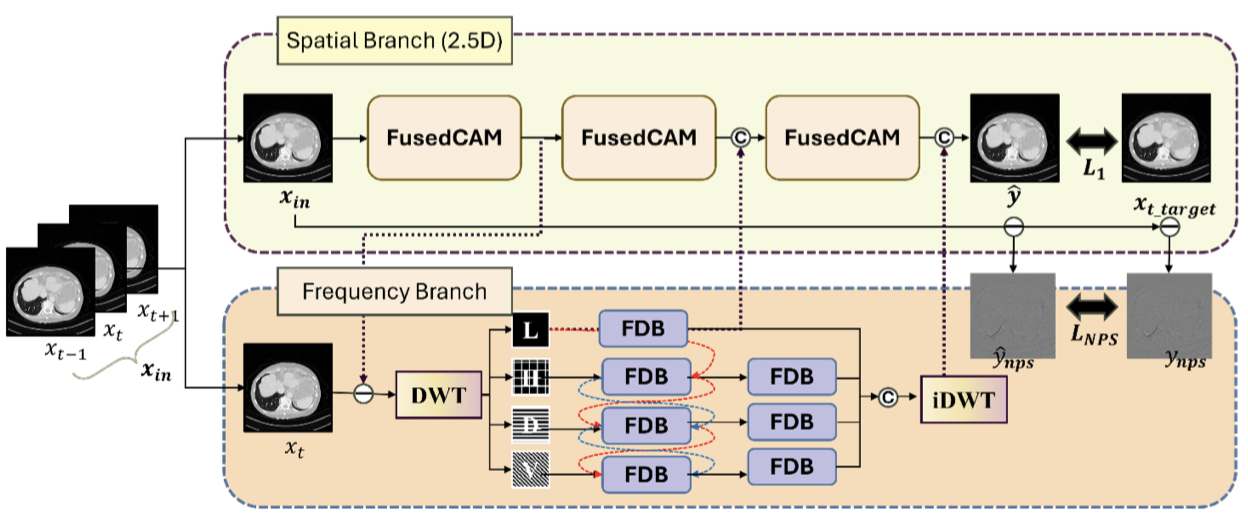
We propose a dual-branch deep learning framework for denoising low-dose CT images while preserving fine textures. The model combines a low-frequency suppression branch and a high-frequency detail recovery branch, utilizing Discrete Wavelet Transform and cross-directional feature fusion. Evaluated on the NIH-AAPM-Mayo Clinic dataset, our method outperforms existing techniques in both noise reduction and texture preservation
S. Jun et al.
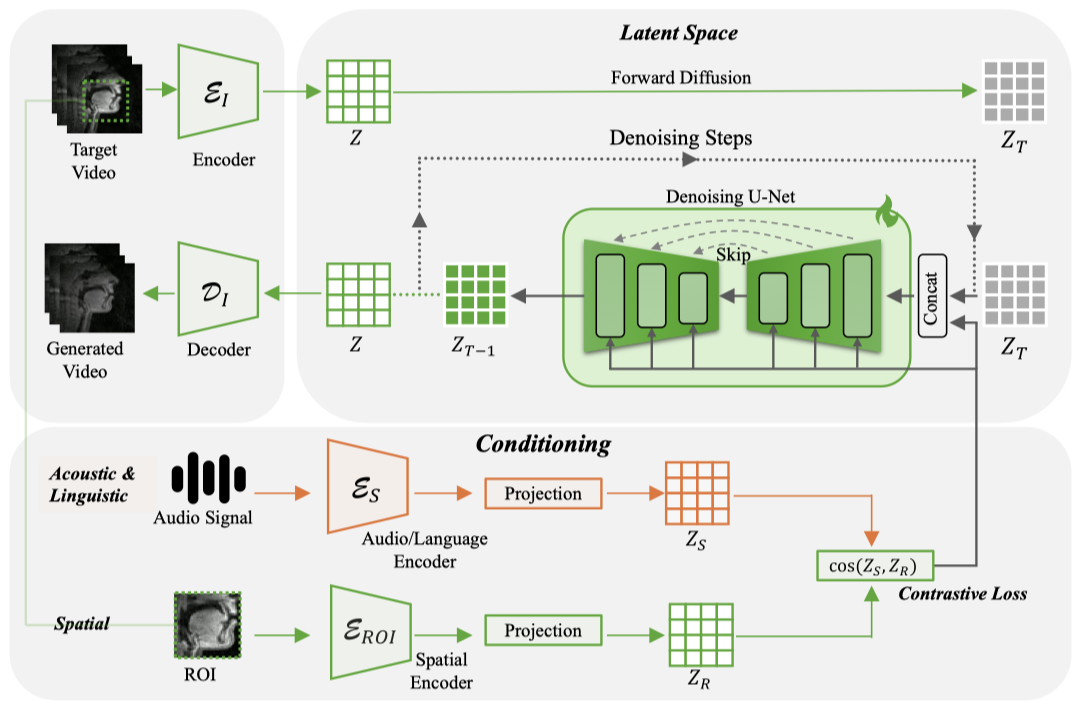
We propose a generative framework that synthesizes anatomically accurate vocal tract MRI sequences directly from speech audio using Whisper’s audio-language representations and region-of-interest alignment, enabling simulation of speech-driven anatomical motion without direct MRI acquisition.
P. Perez-Toro et al.
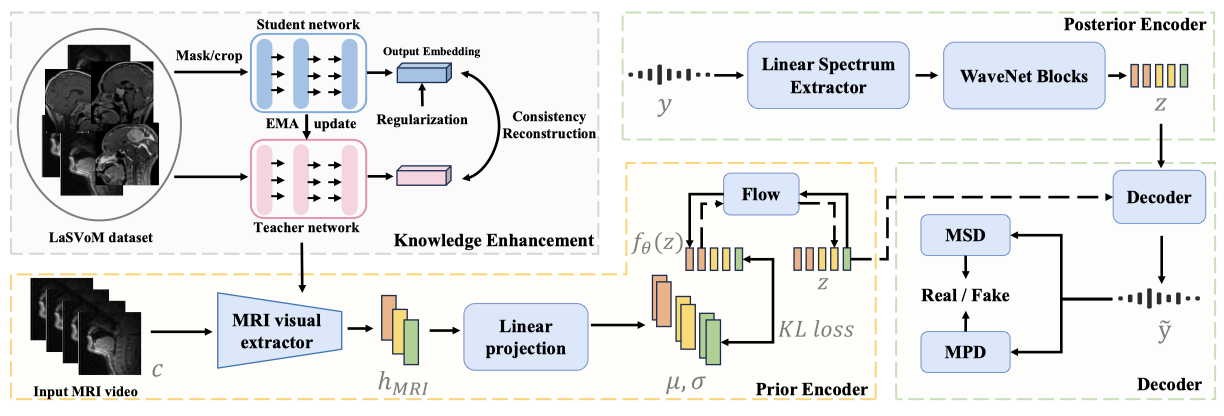
This paper presents a Knowledge Enhanced Conditional Variational Autoencoder (KE-CVAE) that generates speech audio directly from dynamic MRI video sequences of the vocal tract, addressing the critical need for audio recovery when MRI acquisition environments cause systematic data loss, noise, or corruption.
Y. Li et al.
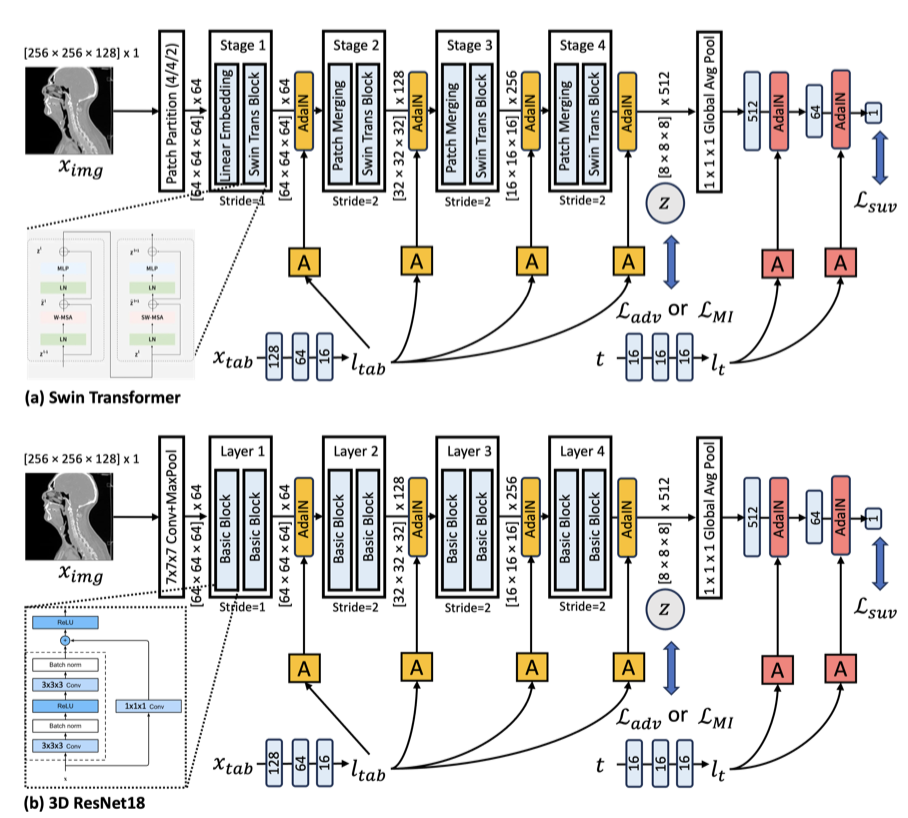
This paper proposes a new deep learning model that can infer individualized treatment effect for head and neck cancer.
J. Wei et al.
APSIPA Trans on Signal and Information Processing (2025)
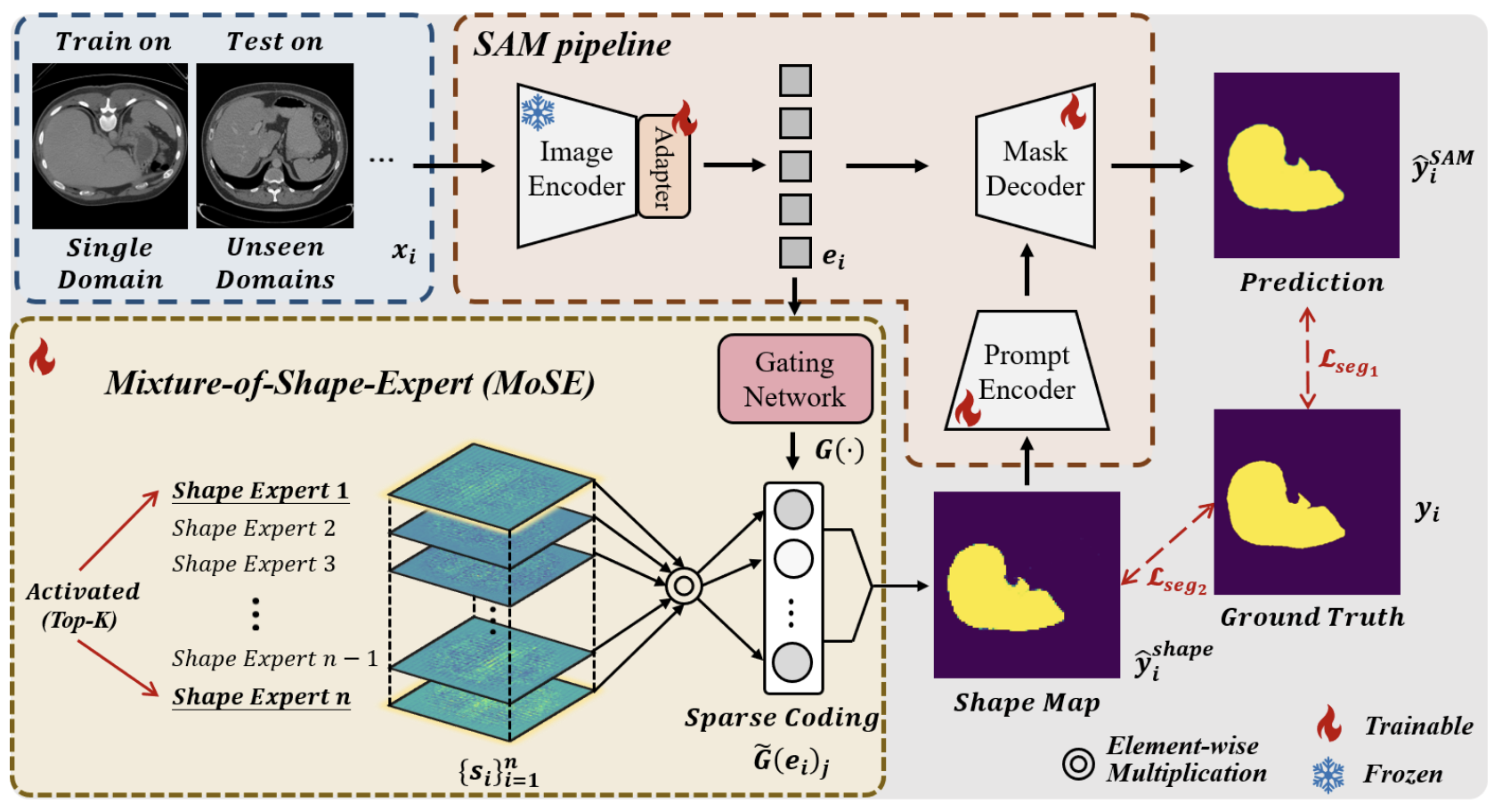
This paper proposes a Mixture-of-Shape-Experts (MoSE) framework that treats dictionary atoms as specialized “shape experts” with sparse activation guided by SAM encoding, integrating bidirectionally with SAM to leverage robust shape priors while preventing overfitting through end-to-end training.
J. Wei et al.

Accurate survival prediction using multimodal magnetic resonance imaging (MRI) plays a crucial role in clinical decision-making for patients with glioblastoma (GBM). We propose GlioSurvNet, a multimodal framework that integrates deep learning features from Swin UNETR with clinical variables to predict patient survival, utilizing multiple MRI sequences to capture diverse tumor characteristics.
G. Kim, F. Xing, H.-J. Kong, E. Santarnecchi, H. Shih, T. Bortfeld, G. El Fakhri, X. Liu, J.-H. Choi, J. Woo

BRITE, our novel tagged MRI tissue motion tracking technique, disentangles anatomy from tag patterns and simultaneously estimates Lagrangian motion by combining denoising diffusion probabilistic models with physics-informed neural networks.
J. Bian et al.

This study developed a deep learning-based diffusion model to automatically and accurately delineate clinical target volumes (CTVs) for soft tissue sarcomas using multi-modality medical images. By training on expert-labeled data and modeling inter-reader variability through confidence maps, the model achieved competitive performance across key metrics compared to U-Net models.
Y. Dong et al.

The proposed domain-adaptive framework for myocardial segmentation uses cine MR data from various manufacturers and employs a class-imbalance self-training structure to address domain shift issues between different scanner systems. The framework iteratively refines the segmentation model using pseudo labels generated in the target domain with a class-specific label threshold to re-balance pixel inconsistencies between different label regions, demonstrating improved segmentation quality compared to other methods when tested on adapting a UNet trained with Siemens scanner data to effectively segment Philips scanner data.
F. Xing, X. Liu, I. Aganj, P. Kim, B. W. Choi, J. Woo
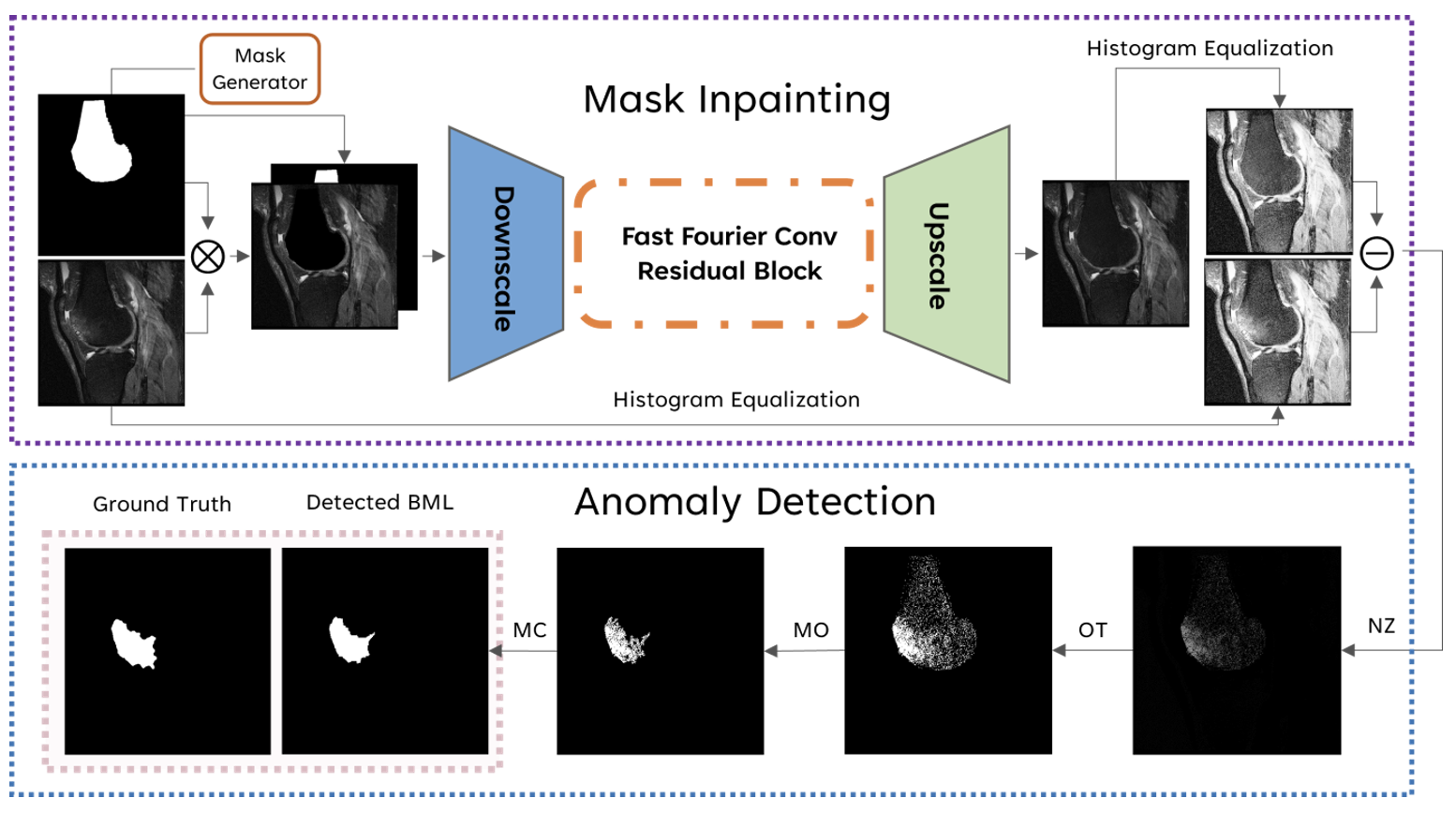
The study proposes a semi-supervised local anomaly detection method using mask inpainting models to effectively identify bone marrow lesions (BMLs) in high-resolution knee MRIs, demonstrating superior performance compared to existing methods. By integrating 3D femur bone segmentation, mask inpainting, and post-processing techniques, the research shows promising results in BML detection, with performance significantly improving on higher-resolution images and potentially advancing imaging-based osteoarthritis research.
S. Qin, M. Zhang, J. Shan, T. Shin, J. Woo, F. Xing
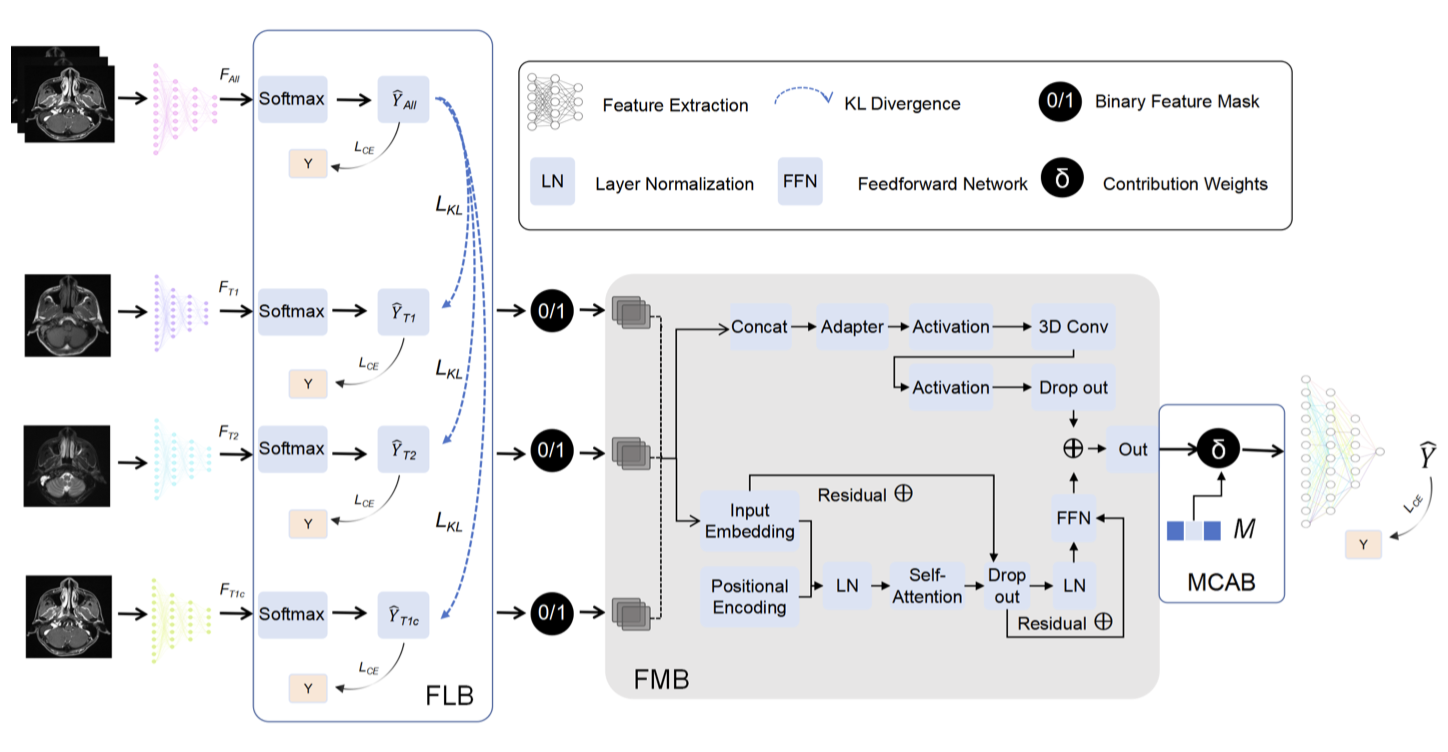
Contrast-enhanced T1-weighted MRI using gadolinium-based contrast agents has been crucial for nasopharyngeal carcinoma diagnosis, but safety concerns have prompted research into alternative methods. This study developed a diagnostic model using non-contrast images that achieved high accuracy comparable to contrast-enhanced imaging, suggesting a promising contrast-free approach for NPC detection.
Z. Li et al.
SPIE Medical Imaging (2025)-Robert F. Wagner All-Conference Best Student Paper Award (Finalist)
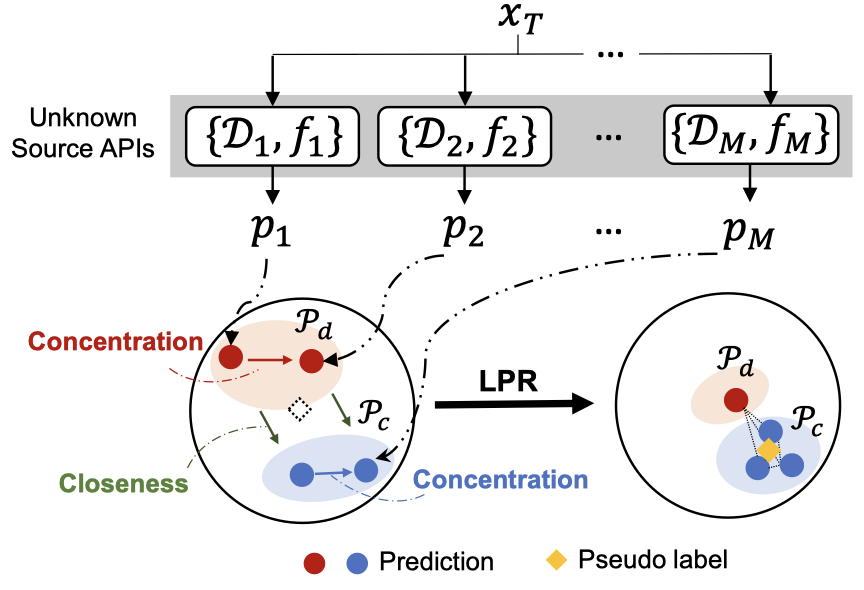
Multi-source Black-box Domain Adaptation using Label space-induced Pseudo label Refinement (LPR) addresses privacy and intellectual property concerns by utilizing only API predictions from multiple source domains, without requiring access to source data or model parameters. The proposed framework introduces a Pseudo label Refinery Network that learns inter-domain relationships through warm-up and refinement phases, with experimental results demonstrating competitive performance compared to state-of-the-art approaches across four benchmark datasets.
C. Yoo, X. Liu, F. Xing, J. Woo and J.-W. Kang
IEEE Trans on Image Processing (2025)

This study proposes an unsupervised framework for coronary lesion detection in computed tomography coronary angiography (CTCA) that uses vessel linearization to generate small linear volume patches and trains a deep autoencoder model exclusively on normal patches to detect anomalies without requiring lesion location labels. Results demonstrate high accuracy on a public dataset with 97.5% accuracy using per-patient average reconstruction error and 85% using the number of patches with high reconstruction error, offering a scalable solution for coronary artery disease detection without relying on large labeled datasets.
D. Kang, J. Choi, J. Woo, C.-C. J. Kuo
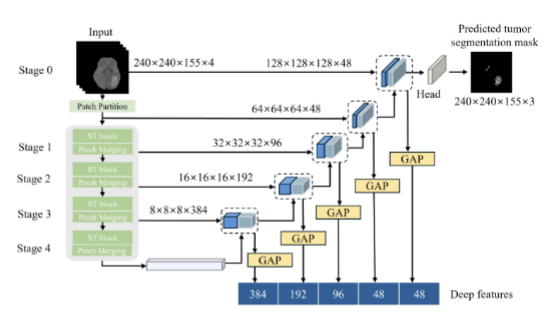
The proposed data-efficient multi-task framework leverages hierarchical segmentation features within advanced Swin UNETR to predict glioblastoma patient survival, integrating multi-scale features to capture detailed spatial information while maintaining computational efficiency. Through segmentation pre-training, feature fine-tuning aligned with survival prediction, and incorporation of age information, the model achieves superior segmentation accuracy and state-of-the-art survival prediction performance on the BraTS dataset, offering a robust solution for clinical prognosis.
G. Kim, F. Xing, H.-J. Kong, E. Santarnecchi, H. Shih, T. Bortfeld, G. El Fakhri, X. Liu, J.-H. Choi, J. Woo

This study developed a deep learning-based diffusion model to automatically and accurately delineate gross tumor volumes (GTVs) for soft tissue sarcomas using multi-modality medical images. By training on expert-labeled data and modeling inter-reader variability through confidence maps, the model achieved competitive performance across key metrics compared to U-Net models.
Y. Dong et al.
Physics and Imaging in Radiation Oncology (2025)
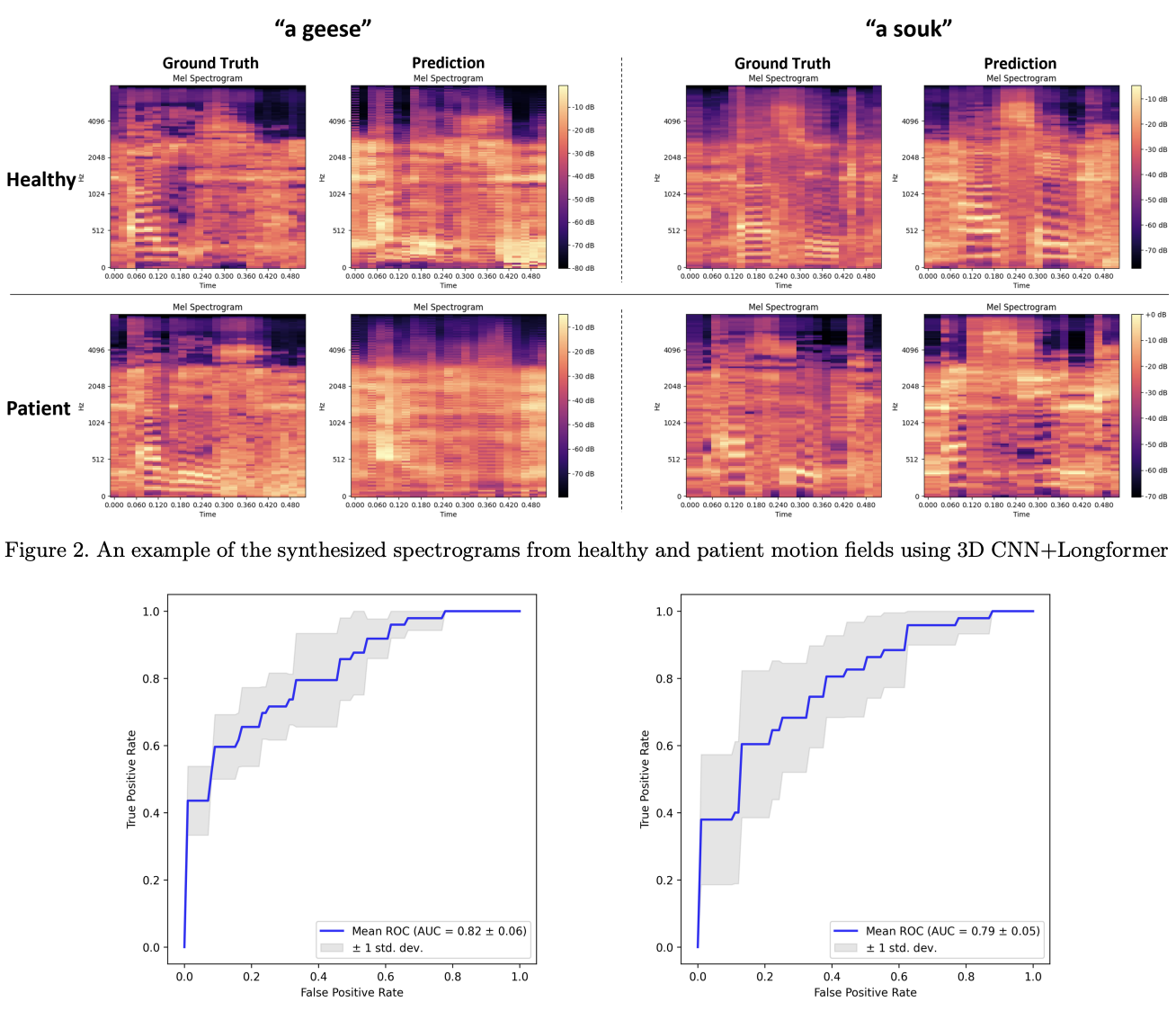
This study develops a framework that detects speech anomalies by using a deep cross-modal translator trained exclusively on healthy individuals’ data to bridge 4D motion fields from tagged MRI with speech spectrograms. The system successfully identifies abnormal speech patterns in tongue cancer patients by leveraging the translator’s limited generalization to out-of-distribution patterns.
X. Liu et al.

This work proposes an improved dynamic speech MRI method using Poisson-disc sampling combined with a locally higher-rank model and regional-optimized temporal basis, which better represents the distinct temporal characteristics of oral and static regions. This approach significantly improves spatiotemporal image quality while reducing overall acquisition time by 50%, achieving 3D dynamic speech MRI with 2-mm isotropic spatial resolution.
R. Jin, Y. Li, R. K. Shosted, F. Xing, I. Gilbert, J. L. Perry, J. Woo, Z.-P. Liang, B. P. Sutton
Magnetic Resonance in Medicine (2024)
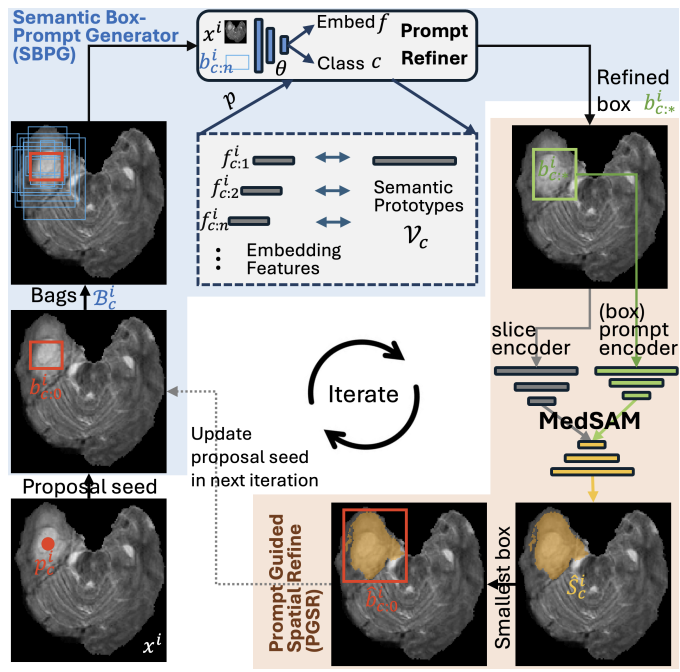
This study introduces an iterative framework to improve point-supervised medical image segmentation by converting point inputs into refined bounding box suggestions and leveraging the MedSAM model’s generalizability. By using a semantic box-prompt generator and a prompt-guided spatial refinement module, we demonstrated superior performance in whole brain tumor segmentation compared to traditional point-supervised segmentation methods.
X. Liu et al.
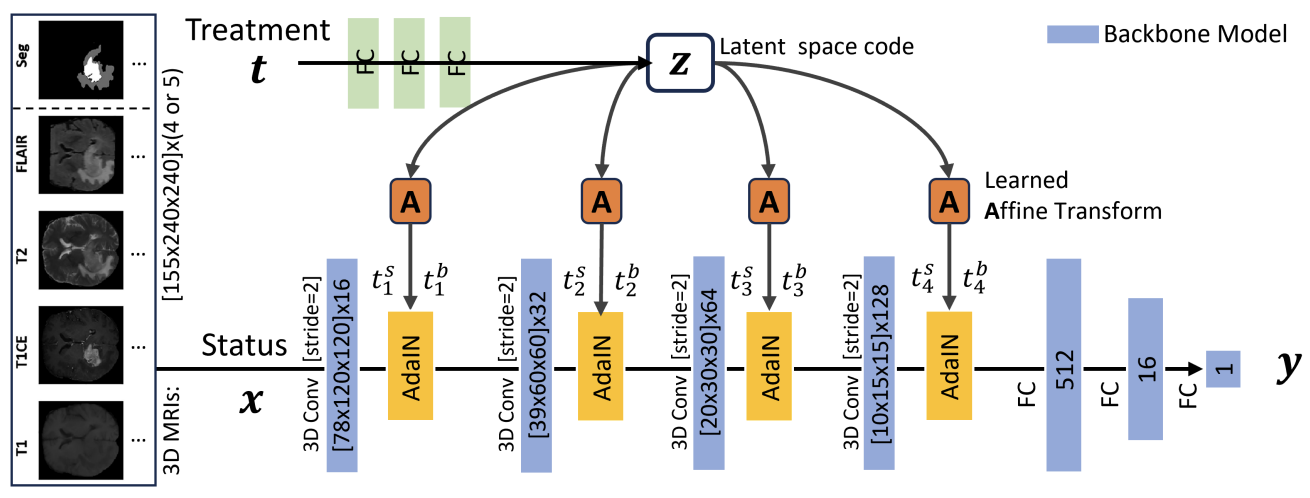
We propose a treatment-conditioned regression model to predict glioblastoma patient survival time using preoperative MR scans and treatment information. Unlike previous approaches that ignored treatment effects, our model incorporates treatment types (GTR, STR, or no resection) using adaptive instance normalization within each convolutional layer. This unified approach improves survival prediction accuracy and enables personalized treatment planning, as demonstrated on the BraTS20 dataset.
X. Liu, N. Shusharina, H. A. Shih, C.-C. J. Kuo, G. El Fakhri, J. Woo

The human tongue moves through a coordinated sequence of internal muscles working together, with five specific muscles being key to pushing the tongue forward (protrusion). Using specialized MRI techniques and statistical analysis, our team discovered that these muscles work in a predictable sequence to create tongue protrusion, advancing our understanding of how the tongue functions.
H. Park et al.
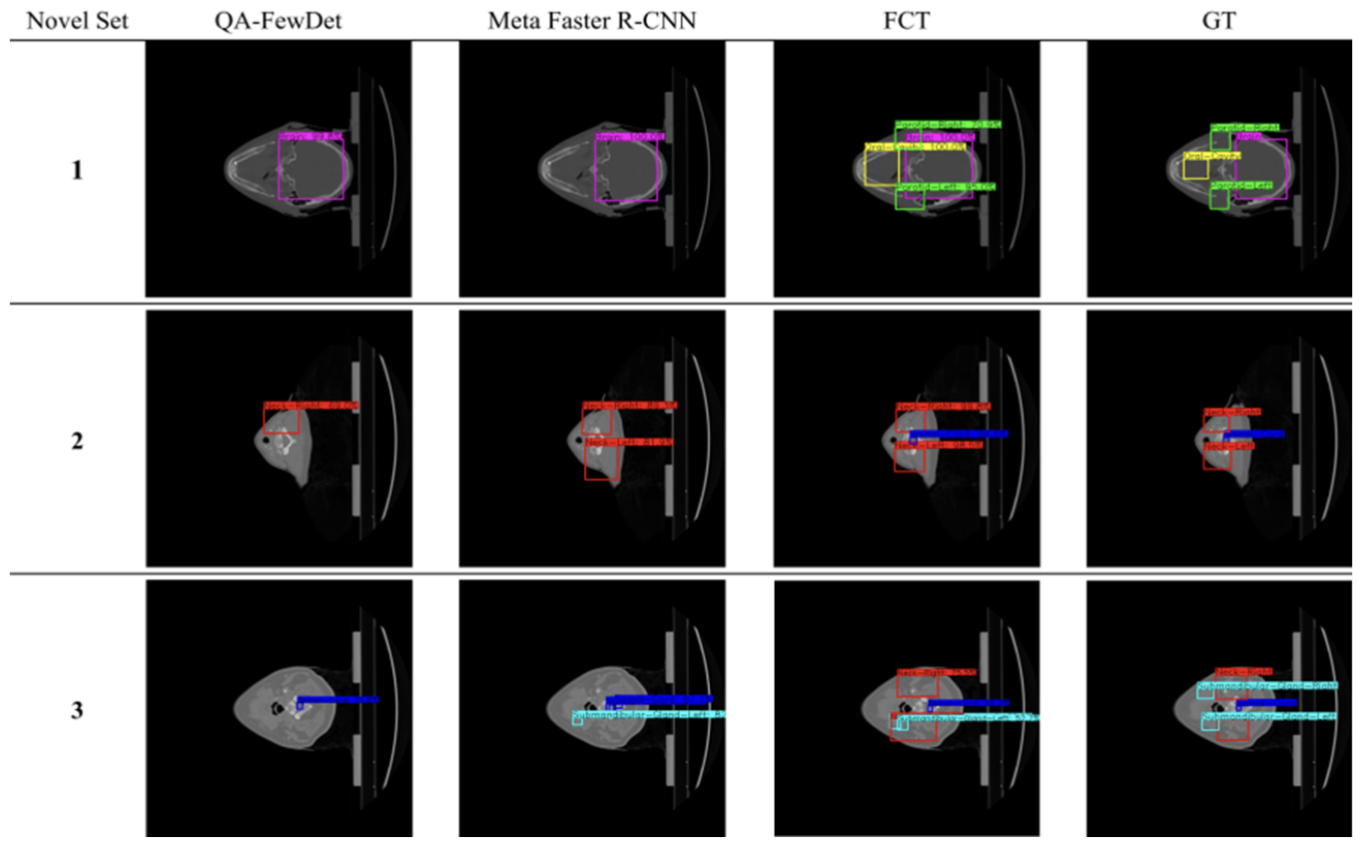
The paper evaluates state-of-the-art few-shot object detection methods for detecting anatomical structures in medical imaging, specifically head and neck anatomy in CT scans. It highlights the challenges posed by variable appearances and limited annotated datasets in medical imaging, motivating the use of few-shot approaches like QA-FewDet, Meta Faster R-CNN, and FCT. Experimental results demonstrate that these methods can accurately detect anatomical structures using novel datasets with few images (1- to 30-shot), showing promising potential for clinical integration.
K. Lee et al.
SPIE Medical Imaging (2024) - Student Travel Award
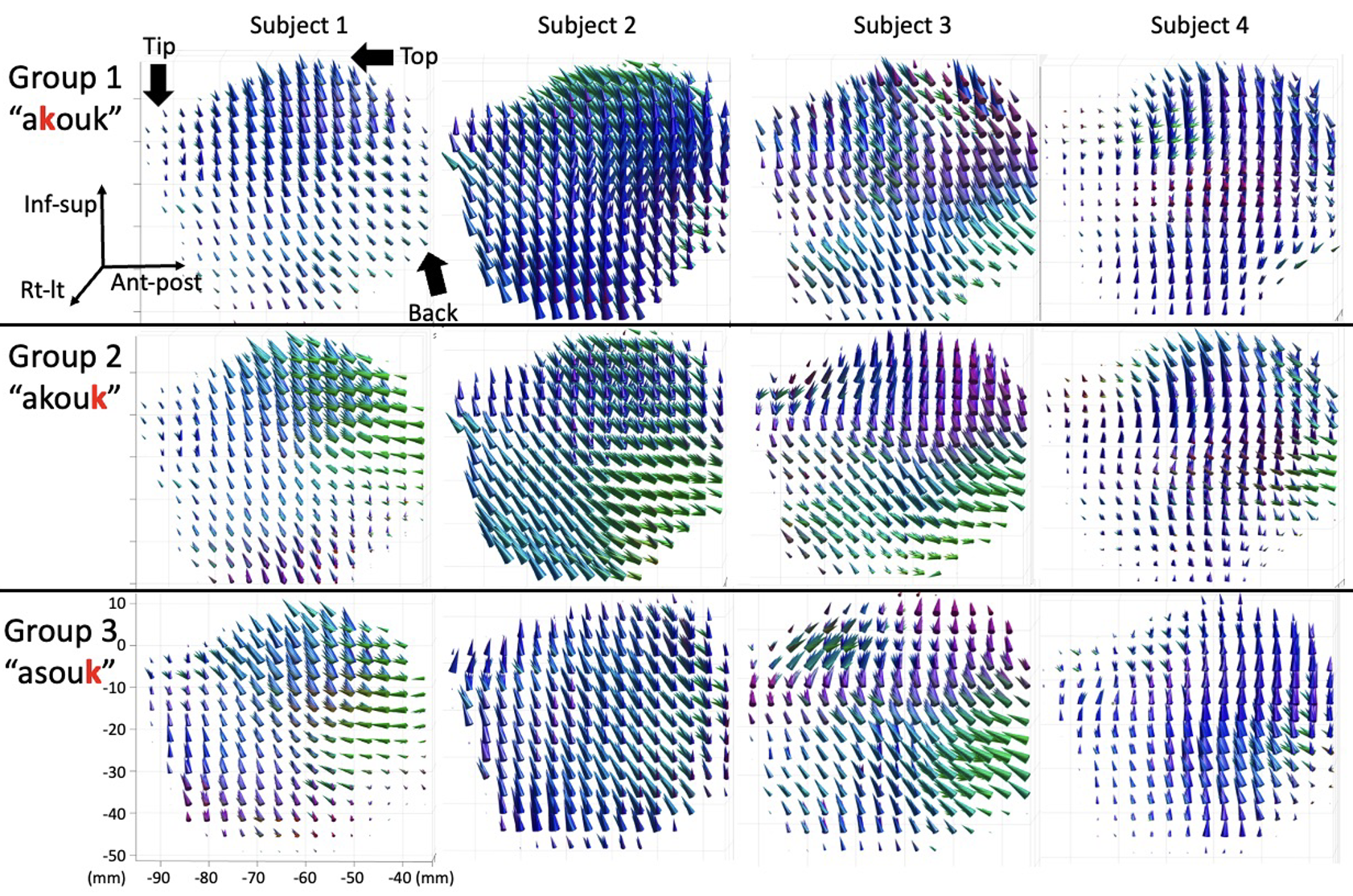
This study explores variations in velar consonant production across different phonological environments using dynamic magnetic resonance imaging (MRI).
F. Xing, J. Zhuo, M. Stone, X. Liu, T. G. Reese, V. J. Wedeen, J. L. Prince, J. Woo
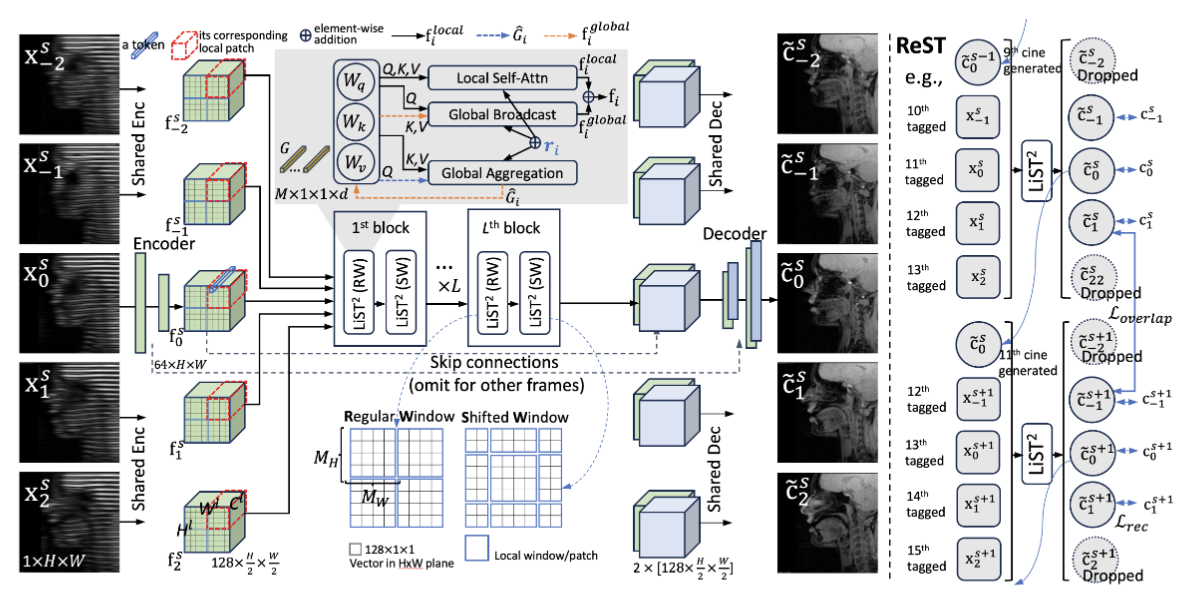
The proposed framework for tagged-to-cine MR sequence synthesis leverages both spatial and temporal information through a light spatial-temporal transformer (LiST2) that exploits local and global attention with relatively lightweight parameters while incorporating directional product relative position-time bias for spatial-temporal correlation awareness. Additionally, a recurrent sliding fine-tuning scheme enhances temporal consistency, resulting in superior performance over comparison methods when evaluated on paired tagged and cine MRI sequences.
X. Liu, F. Xing, Z. Bian, T. Arias-Vergara, P. Andrea Pérez-Toro, A. Maier, M. Stone, J. Zhuo, J. L. Prince and J. Woo

An off-the-shelf model for unsupervised domain adaptation (OSUDA) can be vulnerable to backdoor attacks due to the inability to access or control source domain data, but a proposed method quantifies backdoor sensitivity using a Lipschitz constant and eliminates the infection by overwriting backdoor-related channel kernels, validated on a multi-center cardiac dataset.
X. Liu, F. Xing, H. Gaggin, C.-C. J. Kuo, G. El Fakhri, J. Woo
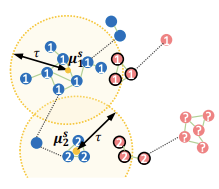
In this work, we develop an unsupervised domain adaptation approach to carry out class-wise conditional alignment.
X. Liu, F. Xing, J. You, J. Lu, C.-C. J. Kuo, G. El Fakhri, J. Woo
IEEE Trans on Neural Networks and Learning Systems (TNNLS) (2024)

Magnetic Resonance Imaging with tagging (tMRI) has long been utilized for quantifying tissue motion and strain during deformation. However, a phenomenon known as tag fading, a gradual decrease in tag visibility over time, often complicates post-processing.
Z. Bian, A. Alshareef, S. Wei, J. Chen, Y. Wang, J. Woo, D. L. Pham, J. Zhuo, A. Carass, J. L. Prince
SPIE Medical Imaging (2024)–Best Student Paper Award
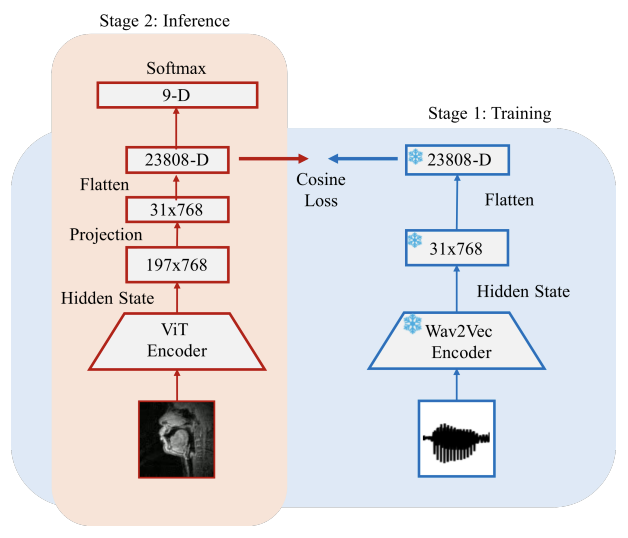
We propose a contrastive learning approach that improves the detection of phonological classes from MRI data when acoustic signals are unavailable, raising frame-wise recognition from an f1 of 0.74 to 0.85. Applied to clinical assessments in tongue cancer patients, this method demonstrates promising results for speech disorder evaluation, potentially enhancing patient outcomes.
T. Arias-Vergara, P. Andrea Perez-Toro, X. Liu, F. Xing, M. Stone, J. Zhuo, J. L. Prince, M. Schuster, E. Noth, J. Woo, A. Maier
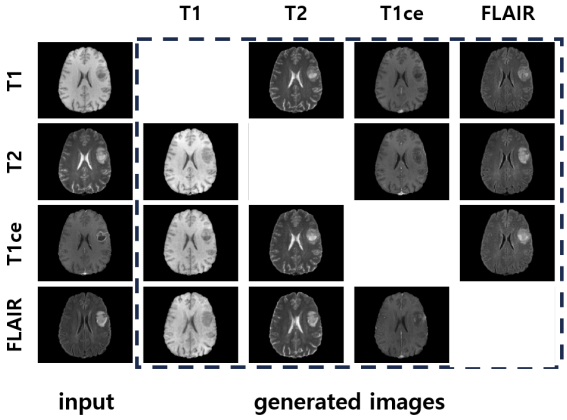
Magnetic Resonance Imaging with tagging (tMRI) has long been utilized for quantifying tissue motion and strain during deformation. However, a phenomenon known as tag fading, a gradual decrease in tag visibility over time, often complicates post-processing.
J. Cho, X. Liu, F. Xing, J. Ouyang, G. El Fakhri, J. Park, J. Woo
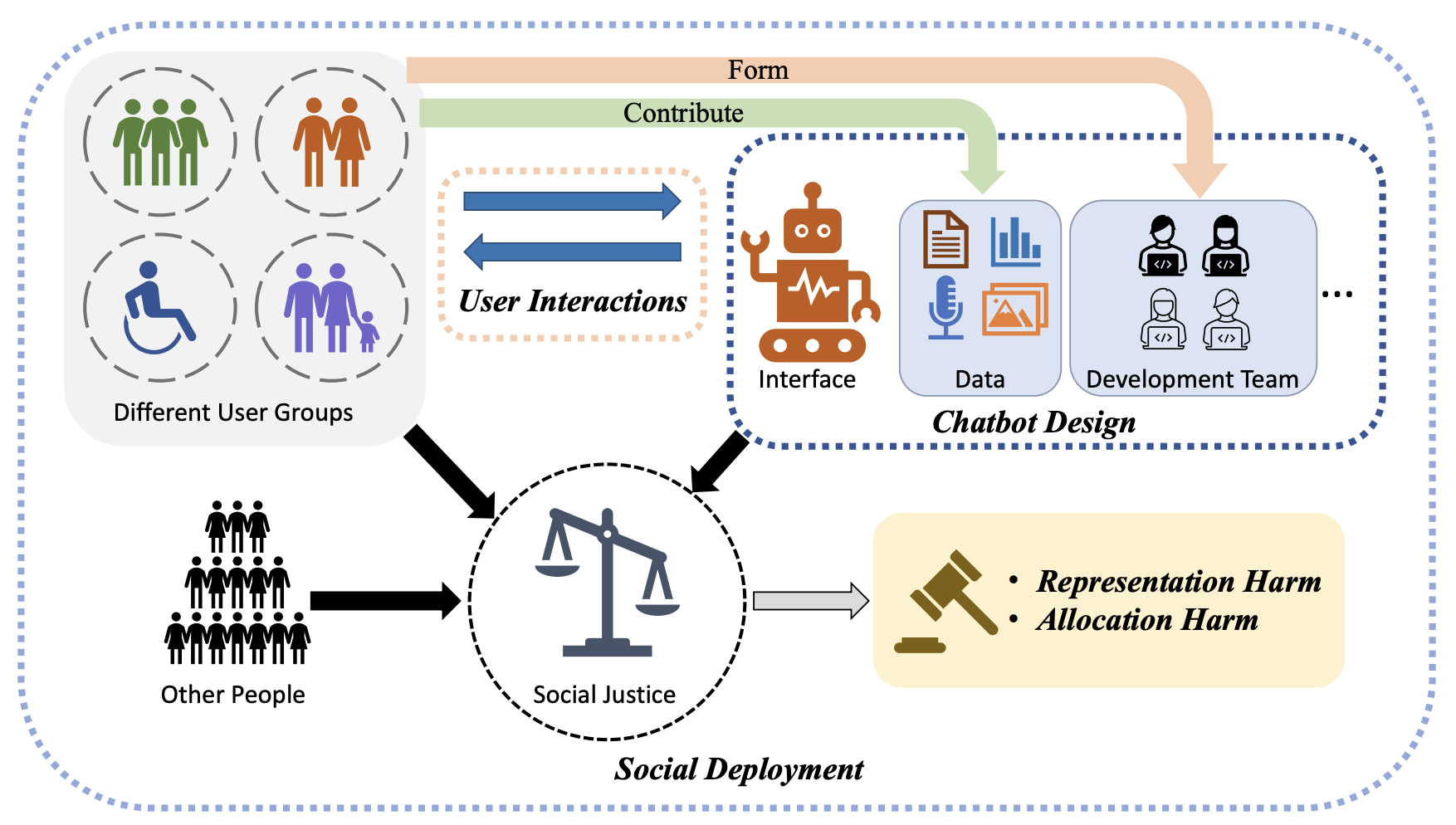
With the rapid development of natural language processing (NLP) technologies in recent years, chatbots using large language models (LLMs) have received much attention nowadays. A comprehensive overview on bias and fairness in chatbot systems is given in this paper.
J. Xue, Y.-C. Wang, C. Wei, X. Liu, J. Woo, C.-C. J. Kuo
APSIPA Trans on Signal and Information Processing (2024)

This study investigates the potential role of 18F-FDG PET in reducing intra- and inter-reader variability thereby improving reproducibility of GTV delineation in STS, without incurring additional costs or radiation exposure.
E. Najem, T. Marin, Y. Zhuo, R. Maria Lahoud, F. Tian, A. Beddok, L. Rozenblum, F. Xing, M. Moteabbed, R. Lim, X. Liu, J. Woo, S. John Lostetter, A. Lamane, Y.-L. Chen, C. Ma, G. El Fakhri
Radiotherapy and Oncology (2024)
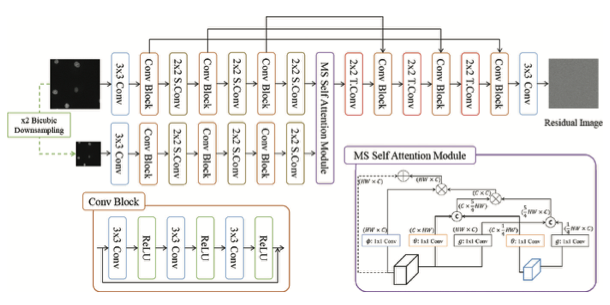
In this work, we develop a new deep learning-based image denoising especially to deal with rapid fluorescence and ultrasound captures where traditional noise mitigation strategies are limited, such as increasing pixel dwell time or frame averaging.
K. Lee, H. Lee, M. Lee, J. Chang, C.-C. Jay Kuo, S.-J. Oh, J. Woo, J. Y. Hwang
APSIPA Trans on Signal and Information Processing (2024)
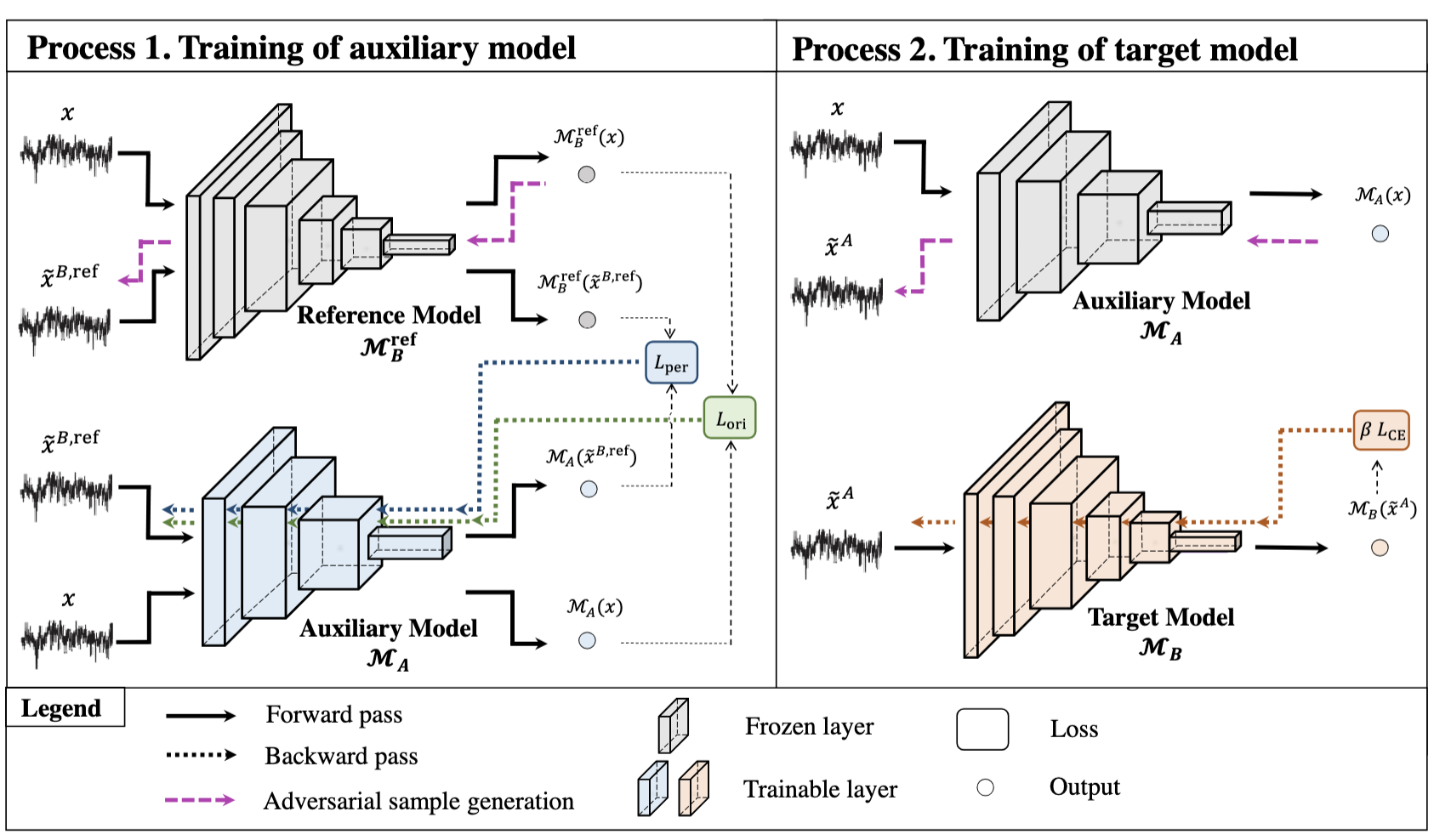
In this work, we develop a noise-robust sleep stage network via adversarial training with an auxiliary model.
C. H. Yoo, X. Liu, F. Xing, G. El Fakhri, J. Woo, J.-W. Kang
IEEE Trans on Biomedical Engineering (2023)
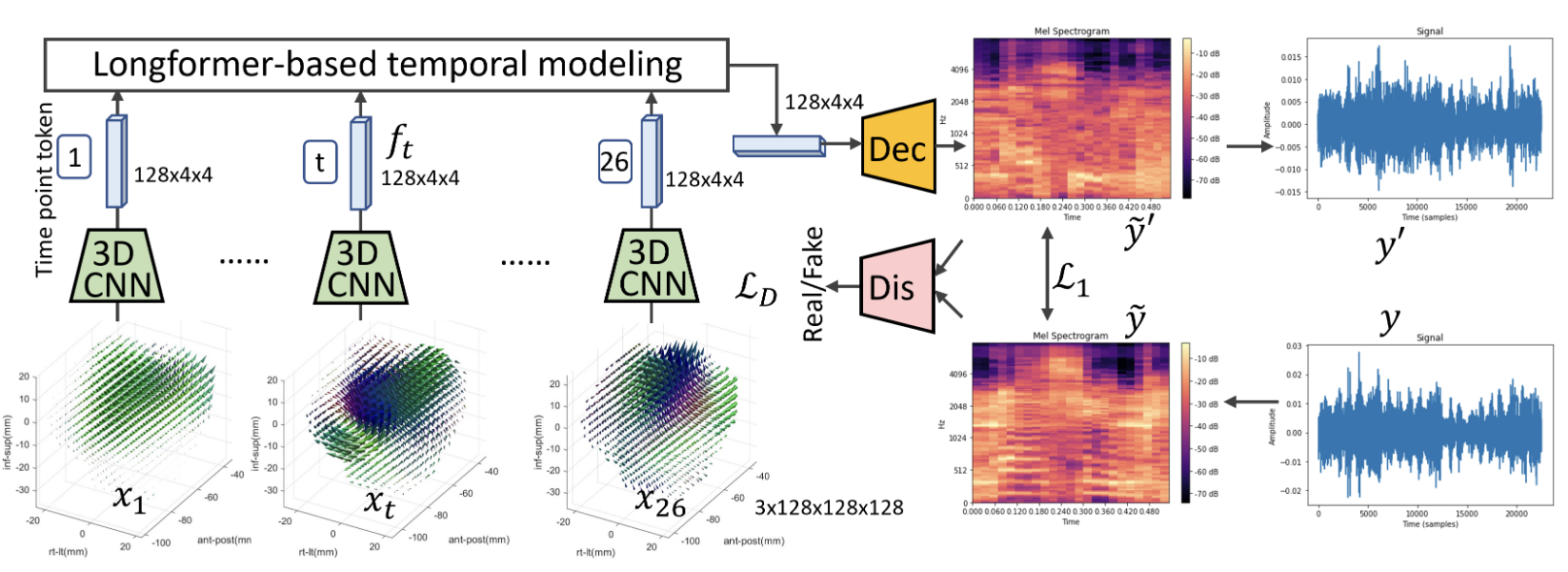
We develop an encoder-decoder translation network using 3D convolutional spatial modeling and transformer-based temporal modeling to predict 2D spectrograms from 4D motion fields,
X. Liu et al.
SPIE Medical Imaging (2023)-Deep dive

This paper presents a novel unsupervised phase-based 3D motion estimation technique for tagged MRI that addresses traditional challenges through two key innovations, including a sinusoidal transformation of harmonic phase input and a Jacobian determinant-based learning objective for incompressibility.
J. Bian et al.

In this work, we seek to progressively evolve an “off-the-shelf” trained segmentation model to diverse datasets with additional anatomical categories in a unified manner.
X. Liu, H. A. Shih, F. Xing, E. Santarnecchi, G. El Fakhri, J. Woo

The Stochastic Confidence Network (SCN) is a novel deep learning model designed to handle outliers in medical imaging, ensuring accurate and robust diagnoses. Experimental results on databases for breast tumors and Alzheimer’s disease demonstrated that SCN significantly improves diagnostic performance by eliminating irrelevant outlier data and resampling outliers into a typical distribution, outperforming state-of-the-art models.
K. Lee, H. Lee, G. El Fakhri, J. Sepulcre, X. Liu, F. Xing, J. Y. Hwang, J. Woo
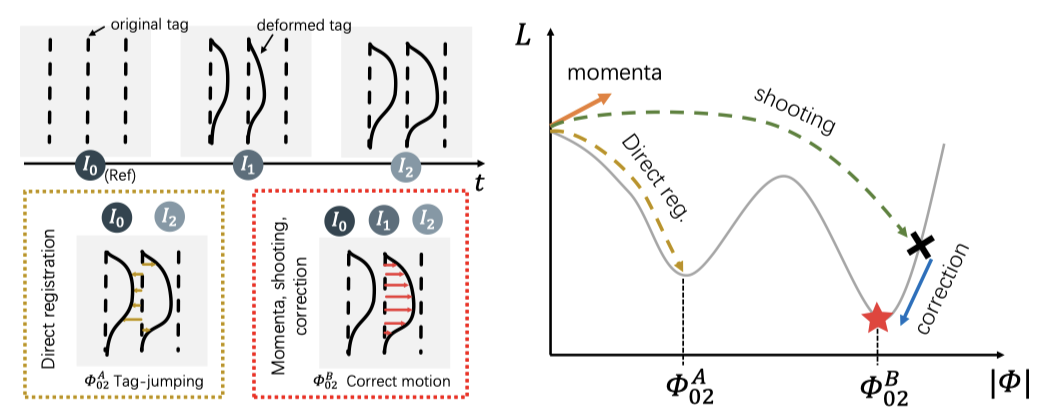
We propose a novel “momenta, shooting, and correction” framework based on Lie algebra and Lie group principles that accumulates momenta in tangent vector space and uses exponential mapping in diffeomorphic space to rapidly approximate true optima while avoiding local minima, demonstrating improved accuracy for dense motion field estimation on both synthetic 2D and real 3D tMRI datasets.
J. Bian et al.
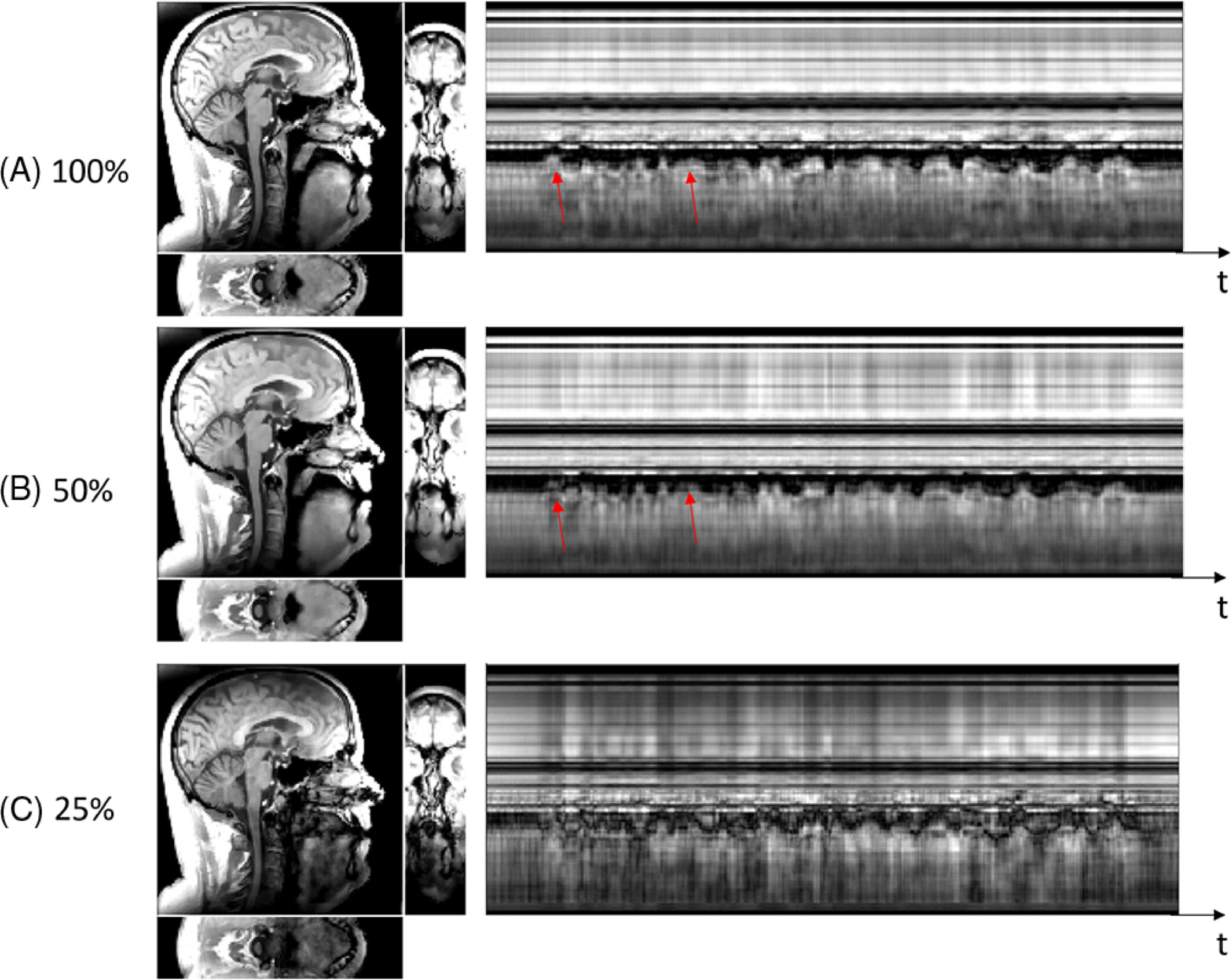
We introduce a highly innovative imaging method to study the complex velopharyngeal system and introduce the potential future clinical applications of a VP atlas in cleft care.
J. Perry, I. Gilbert, F. Xing, R. Jin, D. Kuehn, R. Shosted, J. Woo, Z. P. Liang, B. Sutton
The Cleft Palate Craniofacial Journal (2023)

We developed successive subspace learning for cardiac disease classification from cine MRI.
X. Liu, F. Xing, H. K. Gaggin, C.-C. J. Kuo, G. El Fakhri, J. Woo
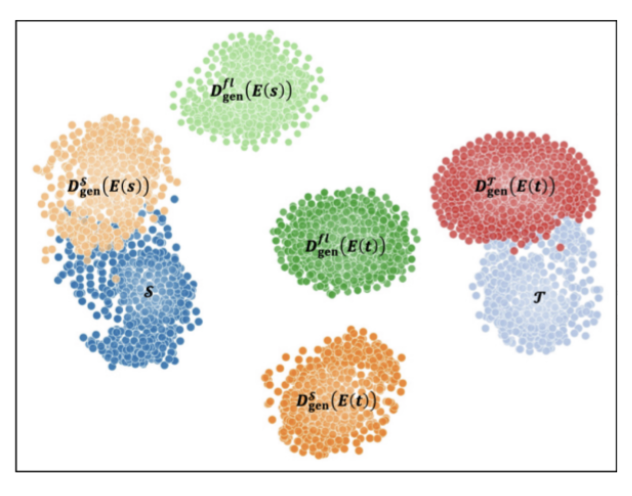
We developed a new self-supervised domain adaptive segmentation method for breast cancer.
K. Lee, H. Lee, G. El Fakhri, J. Woo, J. Y. Hwang
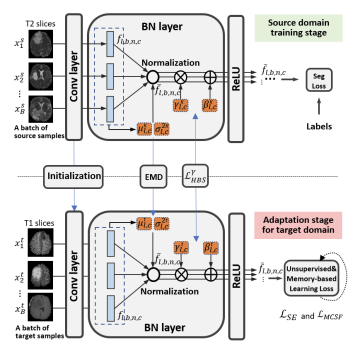
We propose off-the-shelf (OS) UDA (OSUDA), aimed at image segmentation, by adapting an OS segmentor trained in a source domain to a target domain, in the absence of source domain data in adaptation.
X. Liu, F. Xing, G. El Fakhri, J. Woo
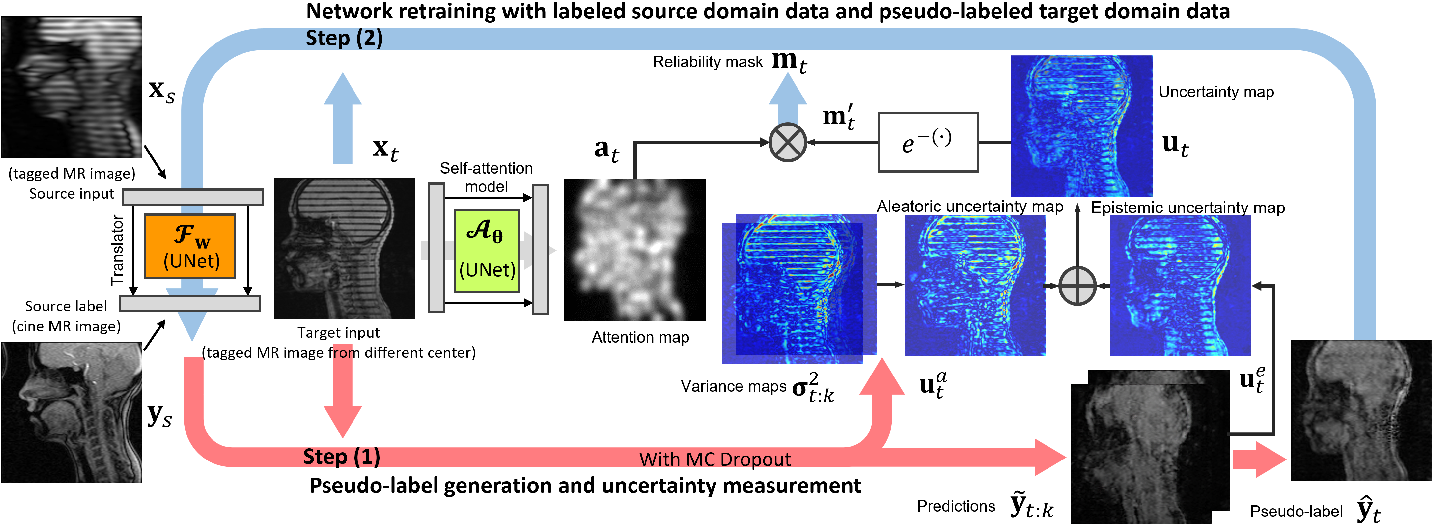
In this work, we developed a generative self-training framework for domain adaptive image translation with continuous value prediction and regression objectives.
X. Liu, J. L. Prince, F. Xing, J. Zhuo, T. Reese, M. Stone, G. El Fakhria, J. Woo
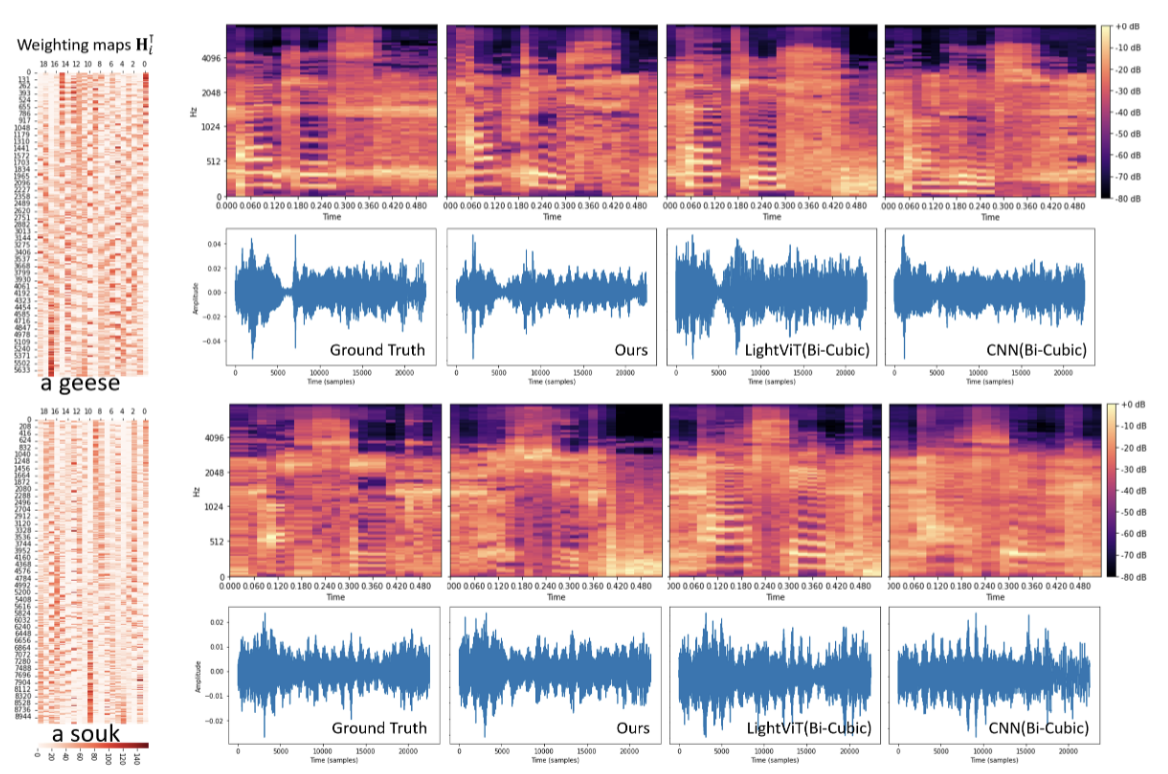
The proposed plastic light transformer (PLT) framework translates tongue motion weighting maps derived from tagged MRI to corresponding audio waveforms through directional product relative position bias and single-level spatial pyramid pooling, enabling flexible processing of variable-sized inputs without information loss. To enhance spectrogram realism despite limited training samples, the framework employs pair-wise utterance consistency with Maximum Mean Discrepancy constraint and adversarial training, outperforming conventional models when tested on 29 subjects speaking two utterances.
X. Liu, F. Xing, M. Stone, J. Zhuo, S. Fels, J. L. Prince, G. El Fakhri, J. Woo
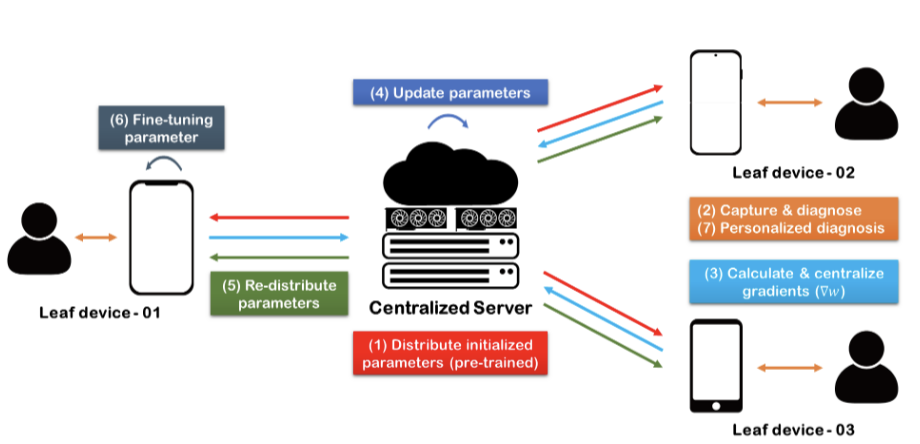
In this work, we developed a federated learning approach for personalized skin diagnosis via fine-tuning network.
K. Lee, H. Lee, T. Coutinho Cavalcanti, S. Kim, G. El Fakhri, D. H. Lee, J. Woo, J. Y. Hwang
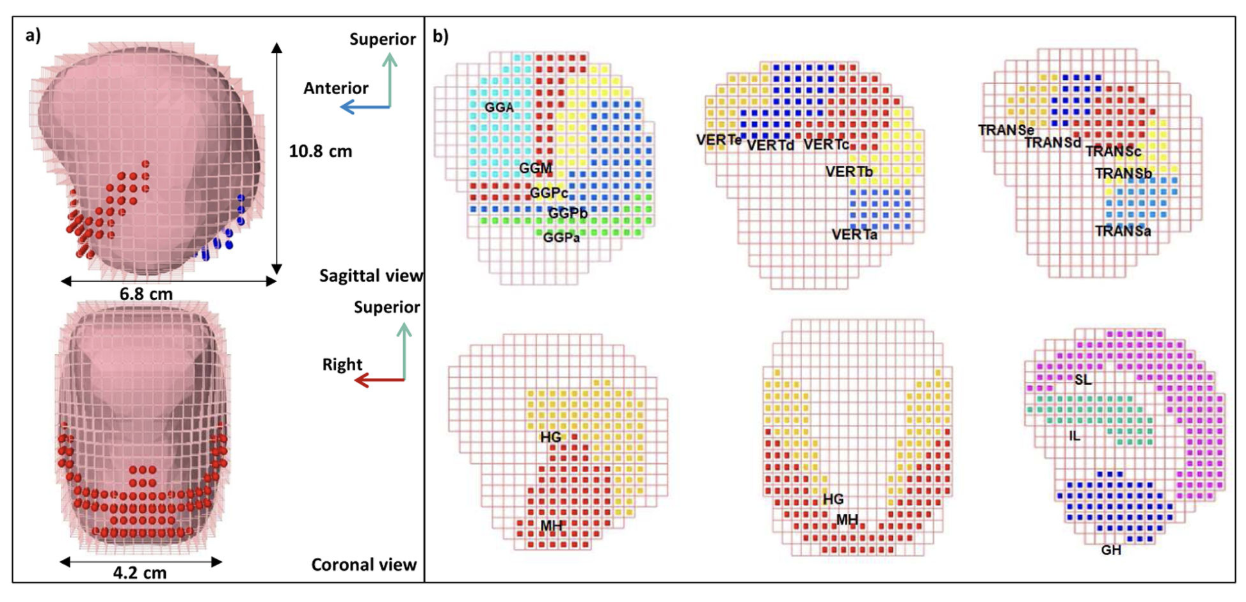
We use inverse atlas tongue modeling for investigating motor control similarity.
U. Maity, F. Xing, J. Prince, M. Stone, G. El Fakhri, J. Woo, S. Fels
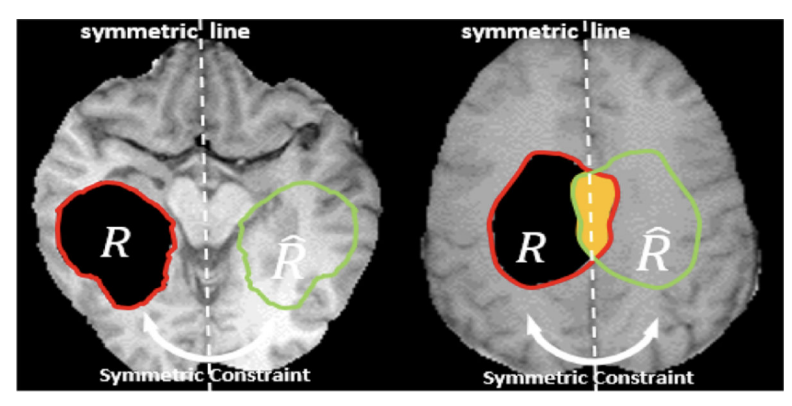
In this work, we developed a method for deep learning based inpainting and applied to construct brain atlases.
F. Xing, X. Liu, C.-C. J. Kuo, G. El Fakhri, J. Woo
IEEE J. Biomed. Health Informatics (2022)
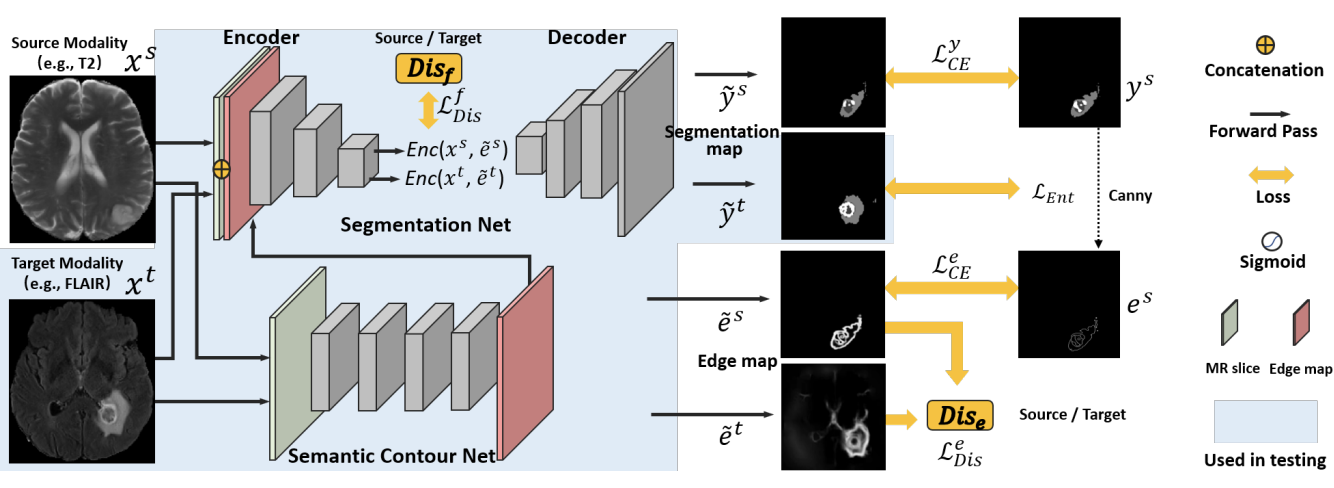
This framework leverages edge information to bridge cross-domain gaps in brain tumor segmentation by jointly training contouring and semantic networks with adversarial learning. Validated on BraTS2018, it outperforms competing methods for cross-modality MRI segmentation
X. Liu, F. Xing, G. El Fakhri, J. Woo

This study focuses on achieving near-isotropic 3D dynamic imaging with high frame rates through sparse temporal sampling and region-of-interest based coil compression, resulting in 1.875 × 1.875 × 2 mm³ spatial resolution with 35.6 fps temporal resolution across a 64-mm coverage.
R. Jin, R. K. Shosted, F. Xing, I. Gilbert, J. L. Perry, J. Woo, Z.-P. Liang, B. P. Sutton
Magnetic Resonance in Medicine (2022)

We develop an end-to-end deep learning framework that uses spectrograms as an intermediate representation and employs a fully convolutional asymmetry translator with self-residual attention, latent space disentanglement, and adversarial training to successfully generate clear audio waveforms from tagged-MRI sequences, demonstrating superior performance over competing methods on 63 sequences.
X. Liu et al.
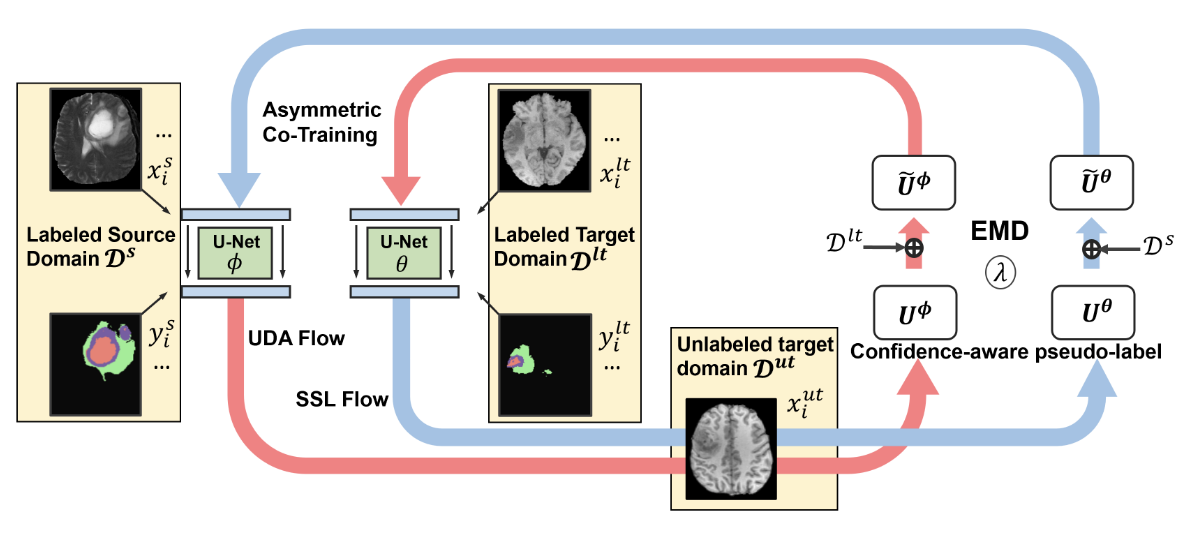
We introduce an asymmetric co-training (ACT) framework that decouples SSDA into semi-supervised learning and UDA sub-tasks, using two segmentors with confidence-aware pseudo-labeling and exponential MixUp decay to achieve marked improvements over existing methods on cross-modality brain tumor MRI segmentation tasks.
X. Liu et al.
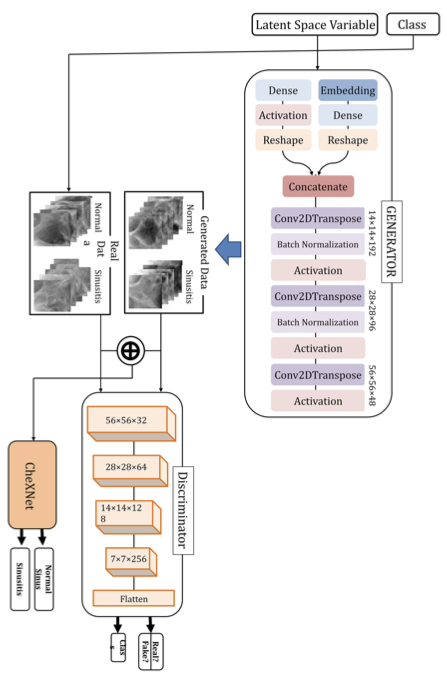
This study addresses the lack of systematic guidelines for determining optimal sample sizes in data augmentation by proposing an automated pipeline using generative adversarial networks (GAN) to enhance diagnostic performance with limited datasets. By demonstrating improved diagnostic parameters in chronic sinusitis radiographs, the research offers a novel approach to overcome training data limitations and potentially assist radiologists in more accurate diagnoses.
H.-J. Kong et al.
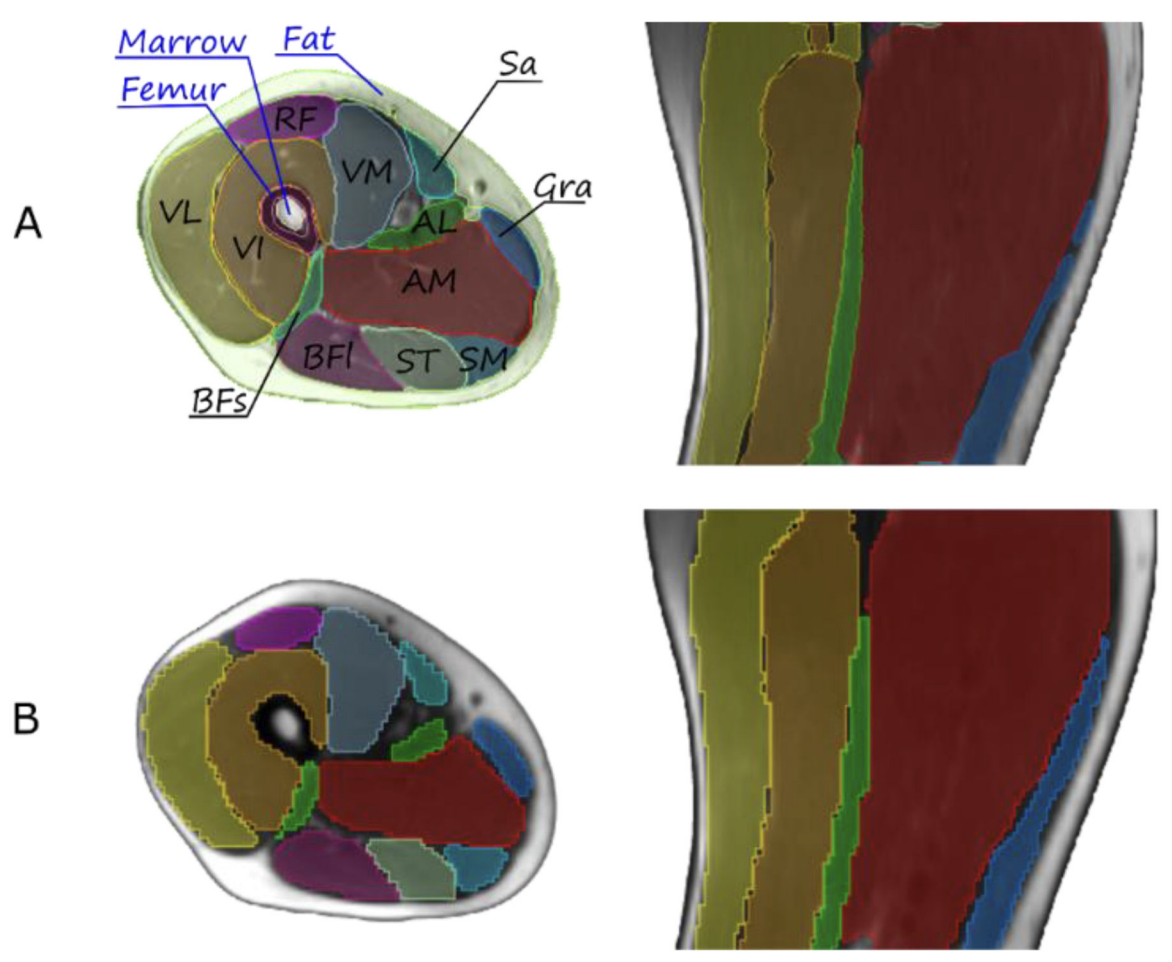
This study explores using diffusion tensor MRI to derive muscle fiber orientations for defining clinical target volume boundaries in soft-tissue sarcoma, leveraging machine learning to auto-segment thigh muscles and develop an anisotropic modeling approach. By comparing fiber orientations across different muscles and subjects, the researchers demonstrated a promising method for more precise tumor boundary delineation that could improve treatment planning for sarcoma patients.
Shusharina et al.
Physics in Medicine and Biology (2022)

Unsupervised domain adaptation (UDA) transfers knowledge from a labeled source domain to unlabeled target domains, addressing the challenge of labeling in new domains. To overcome privacy concerns in cross-center collaborations, we propose a UDA framework using a black-box segmentation model with knowledge distillation and unsupervised entropy minimization, validated on multiple datasets and demonstrating potential in clinical settings.
X. Liu, C. Yoo, F. Xing, C.-C. J. Kuo, G. El Fakhri, J.-W. Kang and J. Woo
Frontiers in Neuroscience (2022)

In this work, we developed a lightweight and interpretable machine learning framework for ALS disease classification from structural MRI.
X. Liu, F. Xing, C. Yang, C.-C. J. Kuo, S. Babu, G. El Fakhri, T. Jenkins, J. Woo
IEEE J. Biomed. Health Informatics (2022)

This review summairzes state-of-the-art deep unsupervised domain adaptation techniques that are proposed in recent years.
X. Liu, C. Yoo, F. Xing, H. Oh, G. El Fakhri, J.-W. Kang, J. Woo
APSIPA Trans on Signal and Information Processing (2022)-Sadaoki Furui Prize Paper Award from APSIPA
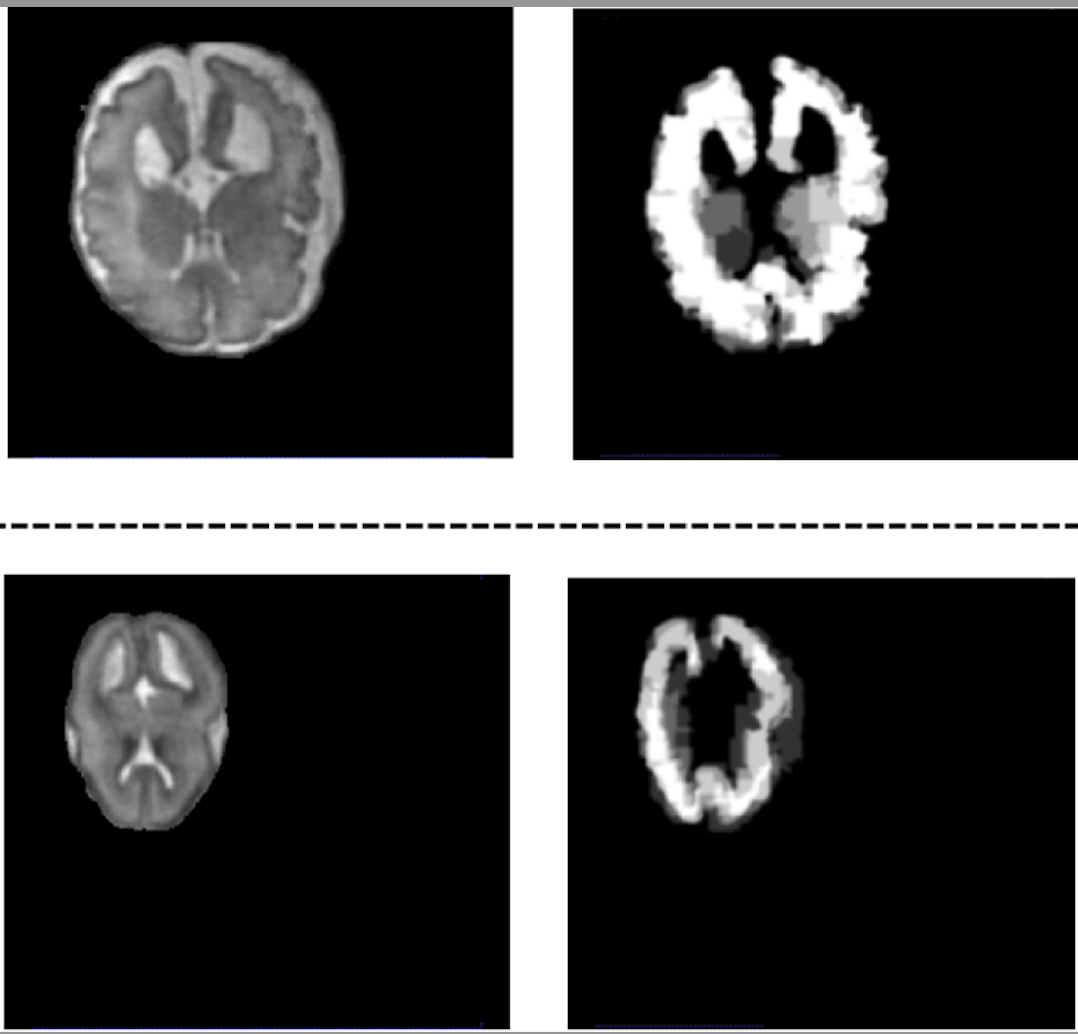
This paper proposes a novel variational inference framework that models the distribution of plausible segmentation maps in MR images to account for inter-observer variability among radiologists without compromising accuracy. Experimental results using QUBIQ brain growth MRI datasets with seven annotators demonstrate how this approach effectively captures the natural ambiguity in medical image segmentation by encoding multi-reader variability in a latent vector and optimizing a variational autoencoder network.
X. Liu, F. Xing, T. Marine, G. El Fakhri, J. Woo
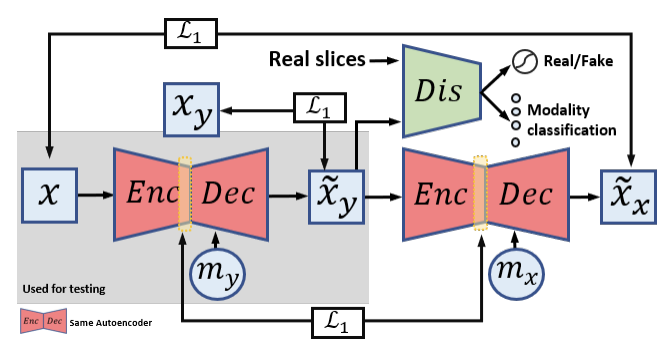
The proposed unified conditional disentanglement framework addresses the challenge of limited multimodal MRI acquisition by enabling synthesis of arbitrary modalities from a single input through cycle-constrained conditional adversarial training. Validated on four MRI modalities from the BraTS’18 database, the framework outperforms comparison methods in synthesis quality and demonstrates effectiveness in tumor segmentation tasks using the synthesized data.
X. Liu et al.

The proposed dual-cycle constrained bijective VAE-GAN approach synthesizes high-resolution cine MR images directly from tagged MR images, eliminating the need for additional acquisitions and reducing scan time and cost. Validated on over 3,700 paired slices from twenty healthy subjects, the method demonstrates superior performance compared to alternatives while maintaining workflow compatibility for subsequent motion analyses.
X. Liu et al.
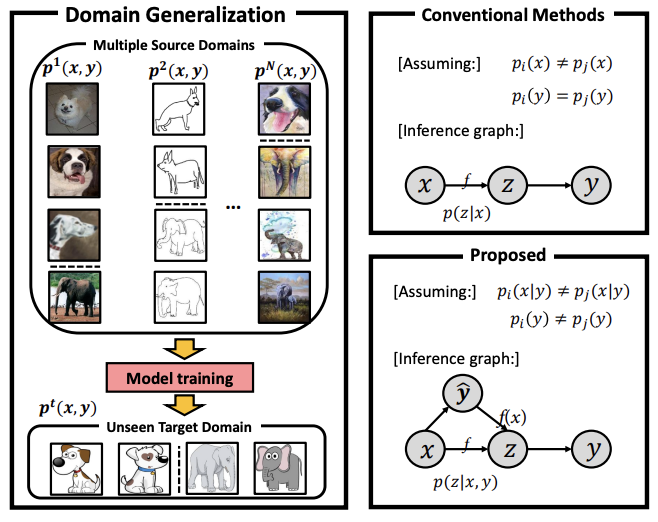
The proposed variational Bayesian framework for domain generalization aligns conditional distributions in latent space while accounting for label shifts, unlike conventional methods that assume label distribution invariance. Experiments demonstrate significant improvements in cross-domain accuracy across multiple benchmarks, confirming the approach’s robustness to realistic domain shifts.
X. Liu et al.

This paper proposes a post-processing workflow that temporally aligns different MR datasets using audio waveforms for matching patterns, applies deformable registration to resample image data, and constructs a four-dimensional dynamic MR speech atlas from four subjects, with similarity tests confirming improved quality for groupwise analysis.
F. Xing et al.

This paper addresses the underexplored area of self-training unsupervised domain adaptation (UDA) for generative tasks like image synthesis, proposing a novel generative self-training (GST) framework that uses uncertainty masks for pseudo-label filtering and variational Bayes learning to quantify predictive confidence in generated images.
X. Liu et al.
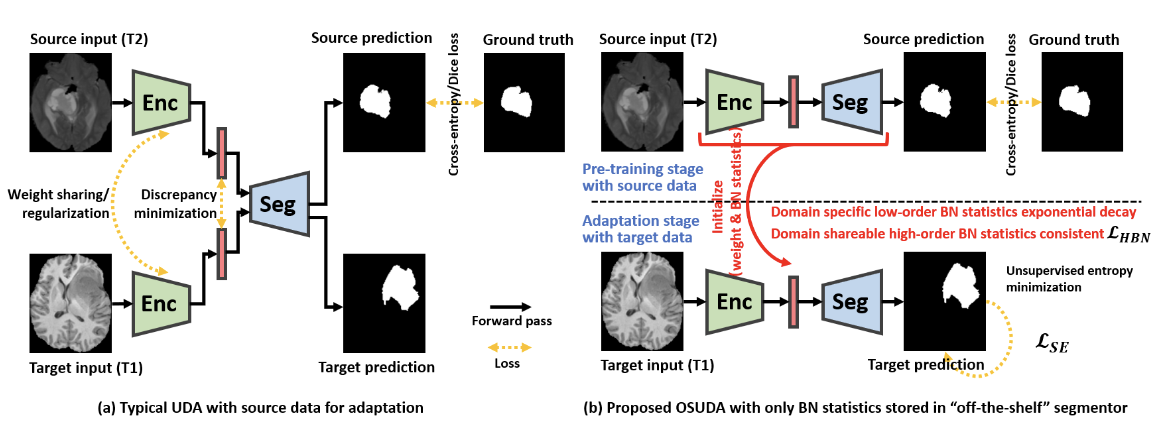
This paper addresses source-free unsupervised domain adaptation (UDA) for segmentation, where access to source domain data is limited due to storage or privacy constraints, by proposing an adaptive batch-wise normalization statistics adaptation framework that gradually adapts low-order statistics (mean and variance) while enforcing consistency of high-order statistics (scaling and shifting parameters.
X. Liu et al.
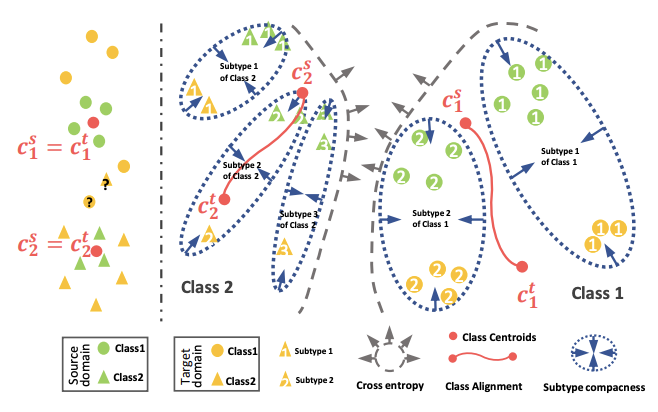
This research proposes a subtype-aware dynamic unsupervised domain adaptation approach that improves cross-domain alignment by discovering and leveraging fine-grained subtype structures within classes, enforcing both class-wise separation and subtype-wise compactness. The method adaptively identifies subtypes with or without prior information on subtype numbers, recognizing that unlabeled subtypes within a class can diverge from each other while maintaining local proximity, achieving promising results on medical diagnosis tasks.
X. Liu et al.
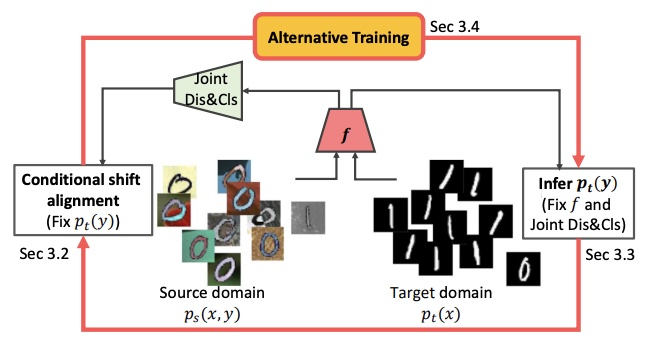
This work proposed an adversarial unsupervised domain adaptation with conditional and label shift.
X. Liu, Z. Guo, S. Li, F. Xing, J. You, C.-C. J. Kuo, G. El Fakhri, J. Woo
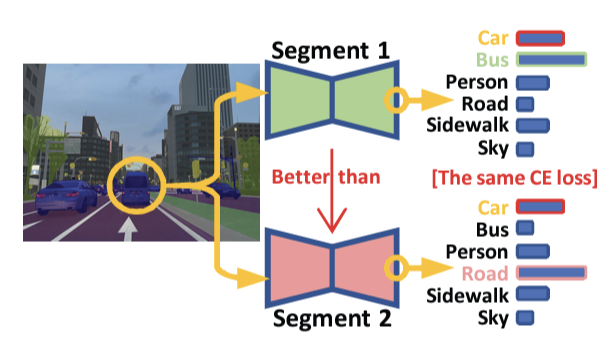
This work proposed severity-aware semantic segmentation with reinforced Wasserstein training.
X. Liu, W. Ji, J. You, G. El Fakhri, J. Woo
Full List of publications
Variance Extrapolated Class-Imbalance-Aware Domain Adaptive Myocardial Segmentation in Multi-Sequence Cardiac MRI
F. Xing et al.
IEEE J. Biomed. Health Informatics (2026)
Deep Learning-Based Non-Contrast MRI Model for Nasopharyngeal Carcinoma Diagnosis: An End-to-End Gadolinium-Free Solution
Z. Li et al.
npj Digital Medicine (2026)
Latent diffusion transformers for 3D head and neck tumor segmentation
Y. Dong et al.
SPIE Medical Imaging (2026)
Frequency-aware inter-branch fusion network for texture-preserving denoising in low-dose CT
S. Jun et al.
SPIE Medical Imaging (2026)
Cross-Modal Diffusion for Region-Aligned Vocal Tract MRI Synthesis
P. Perez-Toro et al.
SPIE Medical Imaging (2026)
Speech Audio Generation from Dynamic MRI via a Knowledge Enhanced Conditional Variational Autoencoder
Y. Li et al.
MICCAI (2025)
Individualized Treatment Effect Inference of Head and Neck Cancer with Multimodal Data
J. Wei et al.
APSIPA Trans on Signal and Information Processing (2025)
Mixture-of-Shape-Experts (MoSE): End-to-End Shape Dictionary Framework to Prompt SAM for Generalizable Medical Segmentation
J. Wei et al.
CVPR Workshop (2025)
GlioSurvNet: Multimodal Survival Prediction for Glioblastoma Using Deep Learning and Clinical Variables from Brain MRI
G. Kim, F. Xing, H.-J. Kong, E. Santarnecchi, H. Shih, T. Bortfeld, G. El Fakhri, X. Liu, J.-H. Choi, J. Woo
IEEE ICIP (2025)
Brightness-Invariant Tracking Estimation in Tagged MR
J. Bian et al.
IPMI (2025)
Modeling Inter-reader Variability in Clinical Target Volume Delineation for Soft Tissue Sarcomas Using Diffusion Model
Y. Dong et al.
Medical Physics (2025)
Domain-adaptive myocardial segmentation using multi-platform cine magnetic resonance images
F. Xing, X. Liu, I. Aganj, P. Kim, B. W. Choi, J. Woo
SPIE Medical Imaging (2025)
Semi-supervised bone marrow lesion detection from knee MRI segmentation using mask inpainting models
S. Qin, M. Zhang, J. Shan, T. Shin, J. Woo, F. Xing
SPIE Medical Imaging (2025)
Contrast-enhanced image-guided learning for nasopharyngeal carcinoma diagnosis using non-contrast MRI
Z. Li et al.
SPIE Medical Imaging (2025)-Robert F. Wagner All-Conference Best Student Paper Award (Finalist)
Label Space-Induced Pseudo Label Refinement for Multi-Source Black-Box Domain Adaptation
C. Yoo, X. Liu, F. Xing, J. Woo and J.-W. Kang
IEEE Trans on Image Processing (2025)
Unsupervised Anomaly Detection Framework for Coronary Artery Lesions in CTCA
D. Kang, J. Choi, J. Woo, C.-C. J. Kuo
IEEE ISBI (2025)
Overall Survival Prediction of Brain Tumor Patients with Multimodal MRI Using Swin UNETR
G. Kim, F. Xing, H.-J. Kong, E. Santarnecchi, H. Shih, T. Bortfeld, G. El Fakhri, X. Liu, J.-H. Choi, J. Woo
IEEE ISBI (2025)
Gross Tumor Volume Confidence Maps Prediction for Soft Tissue Sarcomas from Multi-Modality Medical Images Using a Diffusion Model
Y. Dong et al.
Physics and Imaging in Radiation Oncology (2025)
Speech Motion Anomaly Detection via Cross-Modal Translation of 4D Motion Fields from Tagged MRI
X. Liu et al.
SPIE Medical Imaging (2024)
Optimization of 3D dynamic speech MRI: Poisson-disc undersampling and locally higher-rank reconstruction through partial separability model with regional optimized temporal basis
R. Jin, Y. Li, R. K. Shosted, F. Xing, I. Gilbert, J. L. Perry, J. Woo, Z.-P. Liang, B. P. Sutton
Magnetic Resonance in Medicine (2024)
Point-supervised Brain Tumor Segmentation with Box-prompted MedSAM
X. Liu et al.
IEEE MIC (2024)
Treatment-wise Glioblastoma Survival Inference with Multi-parametric Preoperative MRI
X. Liu, N. Shusharina, H. A. Shih, C.-C. J. Kuo, G. El Fakhri, J. Woo
SPIE Medical Imaging (2024)
Investigating muscle coordination patterns with Granger causality analysis in protrusive motion from tagged and diffusion MRI
H. Park et al.
JASA EL (2024)
Evaluation of few-shot detection of head and neck anatomy in CT
K. Lee et al.
SPIE Medical Imaging (2024) - Student Travel Award
Quantifying articulatory variations across phonological environments: an atlas-based approach using dynamic magnetic resonance imaging
F. Xing, J. Zhuo, M. Stone, X. Liu, T. G. Reese, V. J. Wedeen, J. L. Prince, J. Woo
JASA (2024)
Tagged-to-Cine MRI Sequence Synthesis via Light Spatial-Temporal Transformer
X. Liu, F. Xing, Z. Bian, T. Arias-Vergara, P. Andrea Pérez-Toro, A. Maier, M. Stone, J. Zhuo, J. L. Prince and J. Woo
MICCAI (2024)
Exploring Backdoor Attacks in Off-the-Shelf Unsupervised Domain Adaptation for Securing Cardiac MRI-Based Diagnosis
X. Liu, F. Xing, H. Gaggin, C.-C. J. Kuo, G. El Fakhri, J. Woo
IEEE ISBI (2024)
Subtype-Aware Dynamic Unsupervised Domain Adaptation
X. Liu, F. Xing, J. You, J. Lu, C.-C. J. Kuo, G. El Fakhri, J. Woo
IEEE Trans on Neural Networks and Learning Systems (TNNLS) (2024)
Is Registering Raw Tagged-MR Enough for Strain Estimation in the Era of Deep Learning?
Z. Bian, A. Alshareef, S. Wei, J. Chen, Y. Wang, J. Woo, D. L. Pham, J. Zhuo, A. Carass, J. L. Prince
SPIE Medical Imaging (2024)–Best Student Paper Award
Contrastive Learning Approach for Assessment of Phonological Precision in Patients with Tongue Cancer Using MRI Data
T. Arias-Vergara, P. Andrea Perez-Toro, X. Liu, F. Xing, M. Stone, J. Zhuo, J. L. Prince, M. Schuster, E. Noth, J. Woo, A. Maier
Interspeech (2024)
Disentangled multimodal brain MR image translation via transformer-based modality infuser
J. Cho, X. Liu, F. Xing, J. Ouyang, G. El Fakhri, J. Park, J. Woo
SPIE Medical Imaging (2024)
Bias and Fairness in Chatbots: An Overview
J. Xue, Y.-C. Wang, C. Wei, X. Liu, J. Woo, C.-C. J. Kuo
APSIPA Trans on Signal and Information Processing (2024)
The role of 18F-FDG PET in minimizing variability in gross tumor volume delineation of soft tissue sarcomas
E. Najem, T. Marin, Y. Zhuo, R. Maria Lahoud, F. Tian, A. Beddok, L. Rozenblum, F. Xing, M. Moteabbed, R. Lim, X. Liu, J. Woo, S. John Lostetter, A. Lamane, Y.-L. Chen, C. Ma, G. El Fakhri
Radiotherapy and Oncology (2024)
Multi-Scale Self-Attention Network for Denoising Medical Images
K. Lee, H. Lee, M. Lee, J. Chang, C.-C. Jay Kuo, S.-J. Oh, J. Woo, J. Y. Hwang
APSIPA Trans on Signal and Information Processing (2024)
Noise-Robust Sleep Staging via Adversarial Training With an Auxiliary Model
C. H. Yoo, X. Liu, F. Xing, G. El Fakhri, J. Woo, J.-W. Kang
IEEE Trans on Biomedical Engineering (2023)
Synthesizing audio from tongue motion during speech using tagged MRI via transformer
X. Liu et al.
SPIE Medical Imaging (2023)-Deep dive
DRIMET: Deep Registration for 3D Incompressible Motion Estimation in Tagged-MRI with Application to the Tongue
J. Bian et al.
MIDL (2023)
Incremental Learning for Heterogeneous Structure Segmentation in Brain Tumor MRI
X. Liu, H. A. Shih, F. Xing, E. Santarnecchi, G. El Fakhri, J. Woo
MICCAI (2023)
Outlier Robust Disease Classification via Stochastic Confidence Network
K. Lee, H. Lee, G. El Fakhri, J. Sepulcre, X. Liu, F. Xing, J. Y. Hwang, J. Woo
MICCAI MTSAIL (2023)
MomentaMorph: Unsupervised Spatial-Temporal Registration with Momenta, Shooting, and Correction
J. Bian et al.
MICCAI MTSAIL (2023)
Preliminary Development of an MRI Atlas for Application to Cleft Care: Findings and Future Recommendations
J. Perry, I. Gilbert, F. Xing, R. Jin, D. Kuehn, R. Shosted, J. Woo, Z. P. Liang, B. Sutton
The Cleft Palate Craniofacial Journal (2023)
Successive Subspace Learning for Cardiac Disease Classification with Two-phase Deformation Fields from Cine MRI
X. Liu, F. Xing, H. K. Gaggin, C.-C. J. Kuo, G. El Fakhri, J. Woo
IEEE ISBI (2023)
Self-Supervised Domain Adaptive Segmentation of Breast Cancer via Test-Time Fine-Tuning
K. Lee, H. Lee, G. El Fakhri, J. Woo, J. Y. Hwang
MICCAI (2023)
Memory consistent unsupervised off-the-shelf model adaptation for source-relaxed medical image segmentation
X. Liu, F. Xing, G. El Fakhri, J. Woo
Medical Image Analysis (2023)
Attentive Continuous Generative Self-training for Unsupervised Domain Adaptive Medical Image Translation
X. Liu, J. L. Prince, F. Xing, J. Zhuo, T. Reese, M. Stone, G. El Fakhria, J. Woo
Medical Image Analysis (2023)
Speech Audio Synthesis from Tagged MRI and Non-negative Matrix Factorization via Plastic Transformer
X. Liu, F. Xing, M. Stone, J. Zhuo, S. Fels, J. L. Prince, G. El Fakhri, J. Woo
MICCAI (2023)
Fine-Tuning Network in Federated Learning for Personalized Skin Diagnosis
K. Lee, H. Lee, T. Coutinho Cavalcanti, S. Kim, G. El Fakhri, D. H. Lee, J. Woo, J. Y. Hwang
MICCAI (2023)
Motor control similarity between speakers saying “a souk” using inverse atlas tongue modeling
U. Maity, F. Xing, J. Prince, M. Stone, G. El Fakhri, J. Woo, S. Fels
Interspeech (2023)
Brain MR Atlas Construction Using Symmetric Deep Neural Inpainting
F. Xing, X. Liu, C.-C. J. Kuo, G. El Fakhri, J. Woo
IEEE J. Biomed. Health Informatics (2022)
Self-Semantic Contour Adaptation for Cross Modality Brain Tumor Segmentation
X. Liu, F. Xing, G. El Fakhri, J. Woo
IEEE ISBI (2022)
Enhancing linguistic research through 2‐mm isotropic 3D dynamic speech MRI optimized by sparse temporal sampling and low‐rank reconstruction
R. Jin, R. K. Shosted, F. Xing, I. Gilbert, J. L. Perry, J. Woo, Z.-P. Liang, B. P. Sutton
Magnetic Resonance in Medicine (2022)
Tagged-MRI Sequence to Audio Synthesis via Self Residual Attention Guided Heterogeneous Translator
X. Liu et al.
MICCAI (2022)
ACT: Semi-supervised Domain-adaptive Medical Image Segmentation with Asymmetric Co-training
X. Liu et al.
MICCAI (2022)
Automation of generative adversarial network-based synthetic data-augmentation for maximizing the diagnostic performance with paranasal imaging
H.-J. Kong et al.
Scientific Reports (2022)
Feasibility study of clinical target volume definition for soft-tissue sarcoma using muscle fiber orientations derived from diffusion tensor imaging
Shusharina et al.
Physics in Medicine and Biology (2022)
Unsupervised Black-Box Model Domain Adaptation for Brain Tumor Segmentation
X. Liu, C. Yoo, F. Xing, C.-C. J. Kuo, G. El Fakhri, J.-W. Kang and J. Woo
Frontiers in Neuroscience (2022)
VoxelHop: Successive Subspace Learning for ALS Disease Classification Using Structural MRI
X. Liu, F. Xing, C. Yang, C.-C. J. Kuo, S. Babu, G. El Fakhri, T. Jenkins, J. Woo
IEEE J. Biomed. Health Informatics (2022)
Deep unsupervised domain adaptation: A review of recent advances and perspectives
X. Liu, C. Yoo, F. Xing, H. Oh, G. El Fakhri, J.-W. Kang, J. Woo
APSIPA Trans on Signal and Information Processing (2022)-Sadaoki Furui Prize Paper Award from APSIPA
Variational Inference for Quantifying Inter-observer Variability in Segmentation of Anatomical Structures
X. Liu, F. Xing, T. Marine, G. El Fakhri, J. Woo
SPIE Medical Imaging (2022)
A Unified Conditional Disentanglement Framework for Multimodal Brain MR Image Translation
X. Liu et al.
IEEE ISBI (2021)
Dual-Cycle Constrained Bijective Vae-Gan For Tagged-To-Cine Magnetic Resonance Image Synthesis
X. Liu et al.
IEEE ISBI (2021)
Domain Generalization under Conditional and Label Shifts via Variational Bayesian Inference
X. Liu et al.
IJCAI (2021)
4D magnetic resonance imaging atlas construction using temporally aligned audio waveforms in speech
F. Xing et al.
JASA (2021)
Generative Self-training for Cross-domain Unsupervised Tagged-to-Cine MRI Synthesis
X. Liu et al.
MICCAI (2021)
Adapting Off-the-Shelf Source Segmenter for Target Medical Image Segmentation
X. Liu et al.
MICCAI (2021)
Subtype-aware Unsupervised Domain Adaptation for Medical Diagnosis
X. Liu et al.
AAAI (2021)
Adversarial unsupervised domain adaptation with conditional and label shift: Infer, align and iterate
X. Liu, Z. Guo, S. Li, F. Xing, J. You, C.-C. J. Kuo, G. El Fakhri, J. Woo
ICCV (2021)
Severity-Aware Semantic Segmentation With Reinforced Wasserstein Training
X. Liu, W. Ji, J. You, G. El Fakhri, J. Woo
CVPR (2020)